Reader submitted pictures by way of Beckie Decker.
Pin For Later!

Reader submitted pictures by way of Beckie Decker.

We would possibly obtain a fee while you use our associate hyperlinks. On the other hand, this doesn’t have an effect on our suggestions.
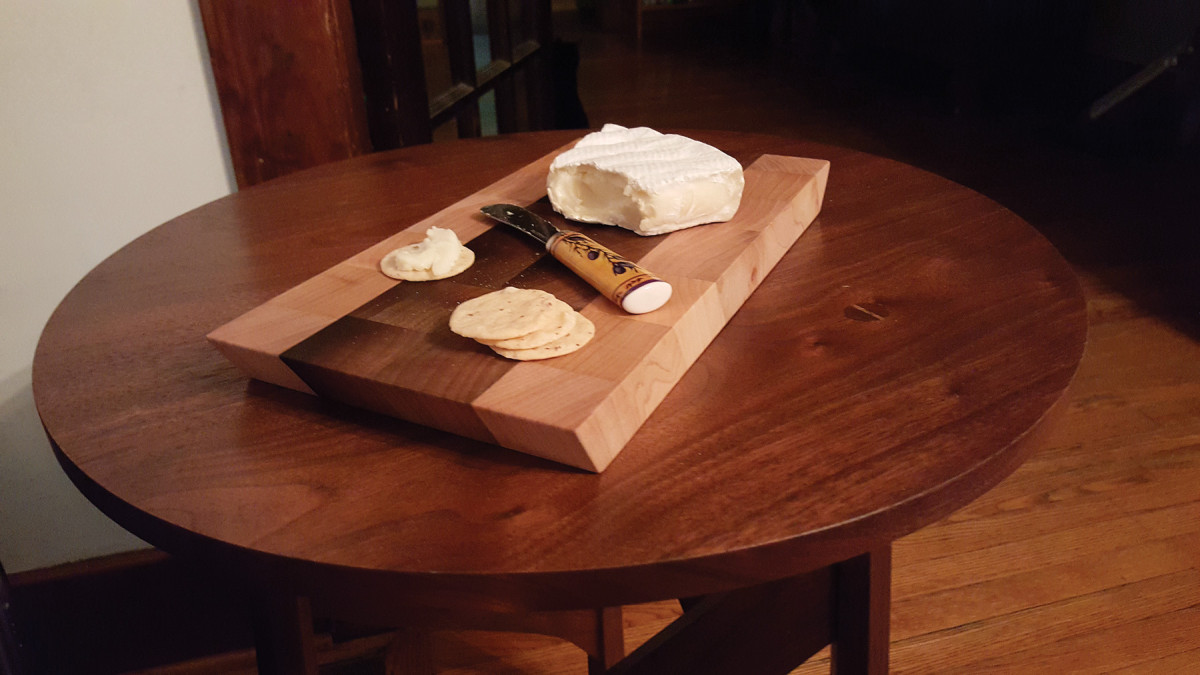
Luthiers have lengthy used roasted or tempered picket in stringed tools for the reason that roasting procedure pre-stresses the picket and caramelizes the sugars, sealing the pores and rendering them extra immune to moisture.

By means of registering, I recognize and conform to Energetic Passion Media’s (AIM) Phrases of Carrier and to AIM’s use of my touch knowledge to be in contact with me about AIM, its manufacturers or its third-party companions’ merchandise, products and services, occasions and analysis alternatives. AIM’s use of the guidelines I supply will probably be in step with the AIM Privateness Coverage.
Some say that birthdays come round extra temporarily the older you get. I don’t know that this is altogether true. I haven’t spotted any distinction. What’s other isn’t celebrating it the similar method. I to find myself being extra thankful that such a lot of rejoice it with me and really feel humbled that you simply took the time to sort out messages to inspire me to “stay on keepin’ on!“
I’m content material to proceed making and for any of a dozen causes. In occasions previous I reached 20 folks in every week who sought after hand gear and talents of their fingers. Many had been content material with their incomes capability in nation-states non-handbook however sought after actual ability and skill that might translate into making stunning issues from wooden. They favored their paintings however felt that making would toughen their lives. Nowadays we achieve loads of hundreds in any given month. They’ve purchased gear new and secondhand and browse my two books on actual woodworking AND they too have turn out to be what they simply at one time dreamed of.
It more or less crept up on me with out my actually realising it. My paintings to make new woodworkers on each and every continent and in each and every nation on the planet turned into actual throughout the web. My shying clear of the theory of creating movies to show didn’t get started with me. I by no means sought after an web presence as a result of I didn’t imagine I may just train that method. I used to be flawed. Others inspired me and made it occur and no longer the least was once my son Joseph as a key participant after which others that climbed on board at the method. So that is to mention thanks to people who paintings along me, my friends and family after which too those that went directly to paintings in other places. After which similarly essential in including which means to my paintings there’s you too! You available in the market who learn my overly-lengthy weblog posts, my poetry, my social output by the use of social media, and so on. Right here’s an excellent large Thank you!
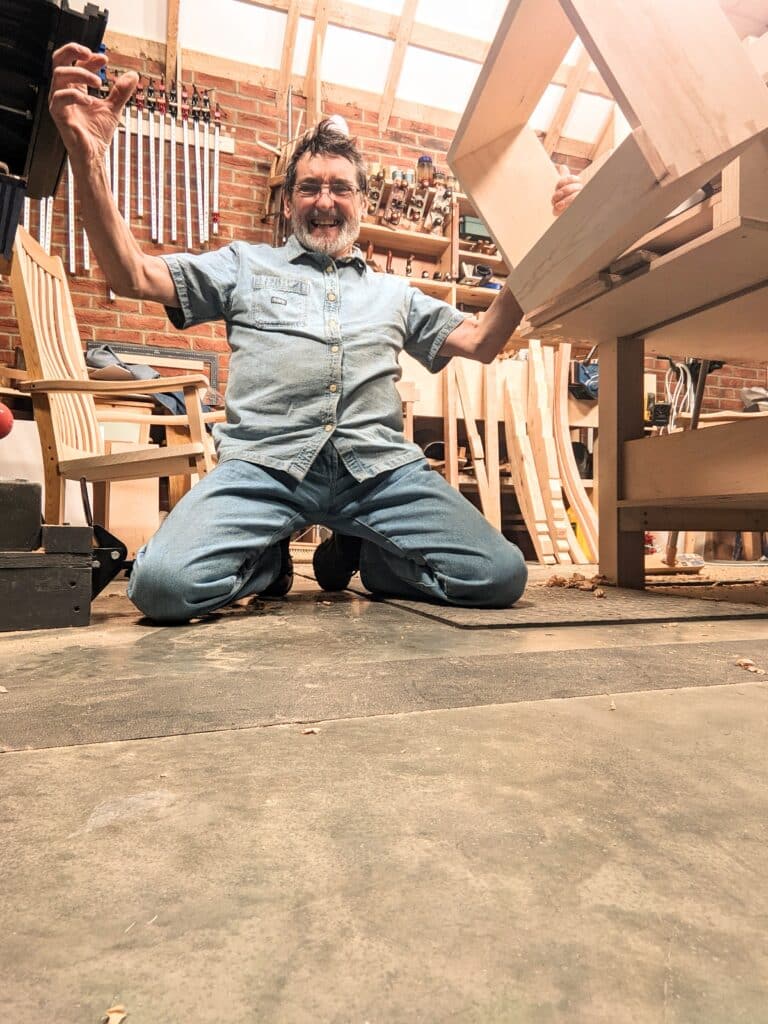

The primary writing magnificence I took at Northwestern’s journalism faculty – “B-01 Elementary Writing” – used to be meant to weed out about one-third of the scholars. You needed to make a “B” within the direction otherwise you had been thrown out.
The category used to be deliberately boot camp-ish. And there have been a number of infractions that will lead to an “F” to your day’s paintings, comparable to misspelling a right kind noun. (I can by no means misspell “Nicaragua” once more.)
In all probability essentially the most dastardly element of the category used to be that you simply had been required to sort the whole lot on guide typewriters within the writing lab. It used to be Spring 1987 after I took that magnificence. And electrical (even Selectric) typewriters had been commonplace, and devoted phrase processors had been within the writing labs for the complicated scholars.

Numerous my fellow scholars had been freaked in regards to the manuals. Plus the way to use correcting fluid. And moans comparable to, “The place is the ‘1’ key? My device is lacking that key!”
Operating on a guide used to be the one benefit I had within the magnificence. For the primary twenty years of my existence, the whole lot I wrote used to be on my guide typewriter, which have been passed all the way down to me by means of my mom. I knew the device inside and outside. I needed to restore the article, oil the article. Blank it to stay it running, particularly the platen. And alter the ribbon, in fact.
I didn’t like electrical typewriters. They made a hum like a worm zapper, and each time I brushed a key by chance I’d soar in my seat. I wished a typewriter that required effort to make use of. And used to be quiet.

I slightly handed Elementary Writing with a B-, absolutely the lowest grade that allowed me to proceed in class. And I continuously characteristic my love of manuals to be the rationale I didn’t get a C or worse.
This week I took supply of an awesome piece of labor that has introduced numerous feelings to the fore. It’s a fully restored 1949 Smith-Corona Silent. A wonderful and compact piece of insane engineering.
The device used to be utterly rebuilt by means of Meagan Syata of the Unplug Typewriter Co. I’ve been following her paintings on Instagram for some time. And one day our paths crossed. Her husband is a woodworker, and so they are living in Hope, Arkansas, my house state. We labored out a industry (I feel I were given the most productive a part of the deal) – one typewriter in alternate for an enormous pile of books.

The typewriter confirmed up the day before today, and I can’t take my eyes or arms off of it. It seems and works find it irresistible is new from the manufacturing facility. And after studying about and observing the whole lot that Meagan does to those machines, I’m really not stunned.
This typewriter goes to get used. I hate writing notes and quick letters by means of hand. My handwriting is horrible. I’m a significantly better typist.
I doubt I’ll ever write a guide the usage of it. However who is aware of? I’ve accomplished stupider issues (comparable to our letterpress model of “Roman Workbenches.”)
To be fair, I don’t have romantic notions about the usage of a guide typewriter. I don’t do detective cosplay, and I’m no longer a “His Lady Friday” reenactor. Like my handplanes and saws, this can be a instrument. And understanding the way to use all of the gear is a part of my DNA.
As a creator with an extended historical past with those machines, it’s great to have the sort of again in my ownership.
You probably have any hobby in any respect in those outdated machines, do take a look at Meagan’s retailer. I’m extremely inspired. Plus, if you are going to buy one, chances are you’ll simply save an outdated typewriter from getting lower up so its keys will also be became jewellery.
— Christopher Schwarz

This week I’ve labored considerably with two gear utilized in woodworking and every so often in different fabrics like stone and plastic. One is definitively referred to as a rasp. Rasps are available quite a lot of widths, lengths and shapes. Hand-made rasps, referred to as hand stitched, will also be dear. My favourites up to now are the ones made by means of Auriou of France; the only I depend on maximum is the Cupboard rasp. This rasp is flat on one aspect and spherical at the reverse face. The top follows a steady boat form culminating in a delightful and helpful level and for many people those are probably the most helpful and sensible varieties irrespective of measurement. Mine is now 13 years outdated and it nonetheless cuts picket greater than smartly; fantastically is the phrase, actually. The smaller and narrower variations, perhaps 1/2″ to three/4″ vast and six-8″ lengthy, are superb for tighter, smaller paintings, shaping handles and such. Regardless of the dimensions, they’re fantastically balanced within the hand and lower fantastically successfully.

Prior to now, I normally prompt the 4-in-hand rasp, the kind utilized by farriers for trimming horse hooves after reshoeing horses. Those are a virtually first rate starter rasp for duties like shaping be that disposing of arduous corners to curves as in spoon and spatula making, reducing forums and so forth, however in recent times those rasps have are available with softer metal and fail to stay their edge for extraordinarily lengthy or are certainly are simply flat poorly made, a facsimile of what used to be the trade same old. When a rasp loses its reducing edges it turns into a bruising put in force bluntly attacking just right picket to go away it extra bruised than finely lower. I really like the type of ‘chew‘ and edge retention you get from the hand-stitched variations as with Auriou and Logier. My hope is that they’re going to proceed to live to tell the tale and stay elevating long run generations of professional rasp makers.
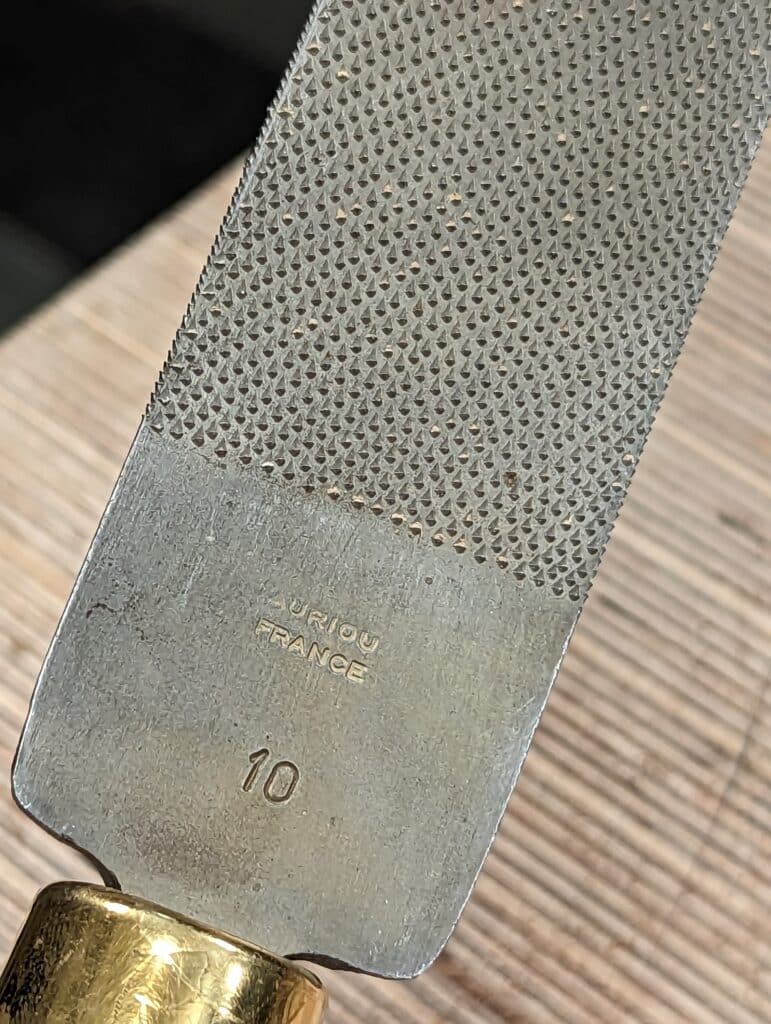
With reference to the 4-in-hand rasp: what’s in point of fact treasured is that you simply get 4 surfaces at the similar rasp. They’ve no take care of because the metal itself is the dangle you get and what you’ve is just right grip. The flat aspect will give you a part-period of exact rasp with the crucial layers of barbed sewing whilst the opposite part of the period is basically a report with finer reducing and smoothing skill. The opposite aspect is spherical and in this aspect, you once more get the rasp and report however within the spherical as a way to talk. It’s not that i am positive why the most productive makers of rasps have now not replicated a best-notch model of this device — a 12-14″ lengthy model with the boat-formed ends can be a wonderfully useful gizmo and most definitely a absolute best dealer for them. Nudge, nudge! Neatly inside their capability.
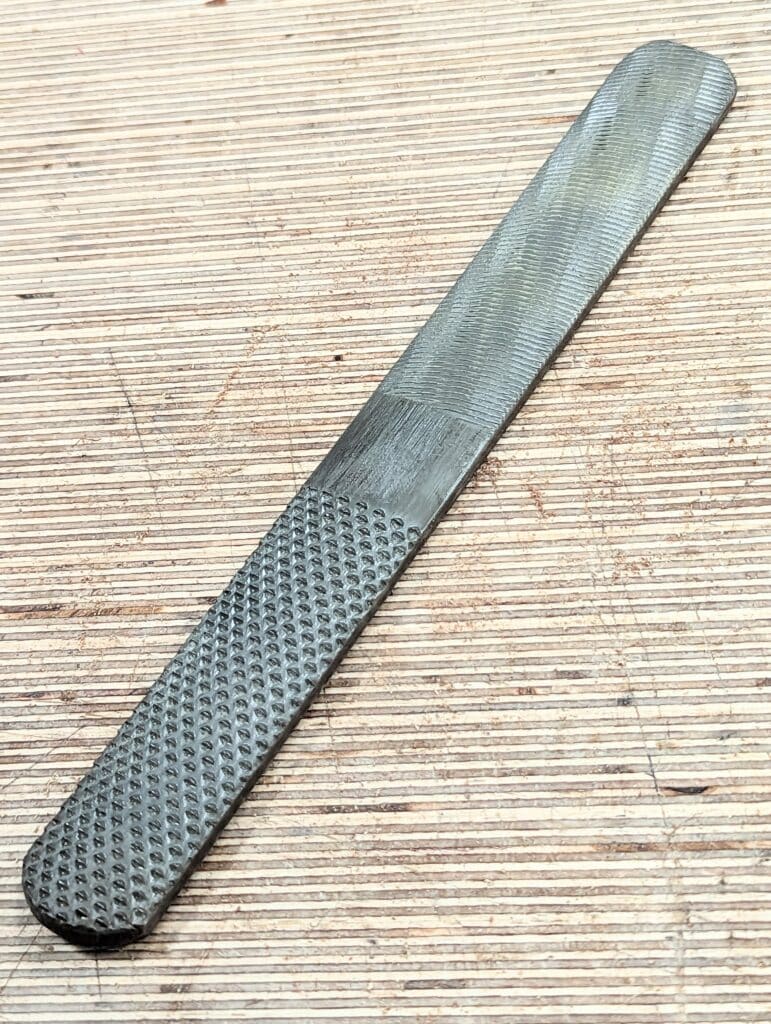
I take note the day I switched from the 4 in hand to the Auriou cupboard rasp; the 12″ #10 sewing. It used to be an evening and day enjoy but I additionally recall a 4-in-hand model that used to be in point of fact smartly made and intensely at hand all in one device. They impulsively declined in high quality and this used to be a right away results of less expensive imports robbing first rate makers by means of coming in at not up to part the cost with a glance-alike that fooled everyone into pondering they have been if truth be told getting one and the similar device. By the point everybody realised the adaptation, the great makers have been long past. That mentioned, 4-in-arms as distinct from farrier’s rasps do paintings and paintings smartly sufficient. They’re simply inferior to the top class variations. They are perfect for seeing if what you need to make use of rasps for shall be part of your long run; we ceaselessly use a transitional device like this ahead of we spend cash. on further particular ones.
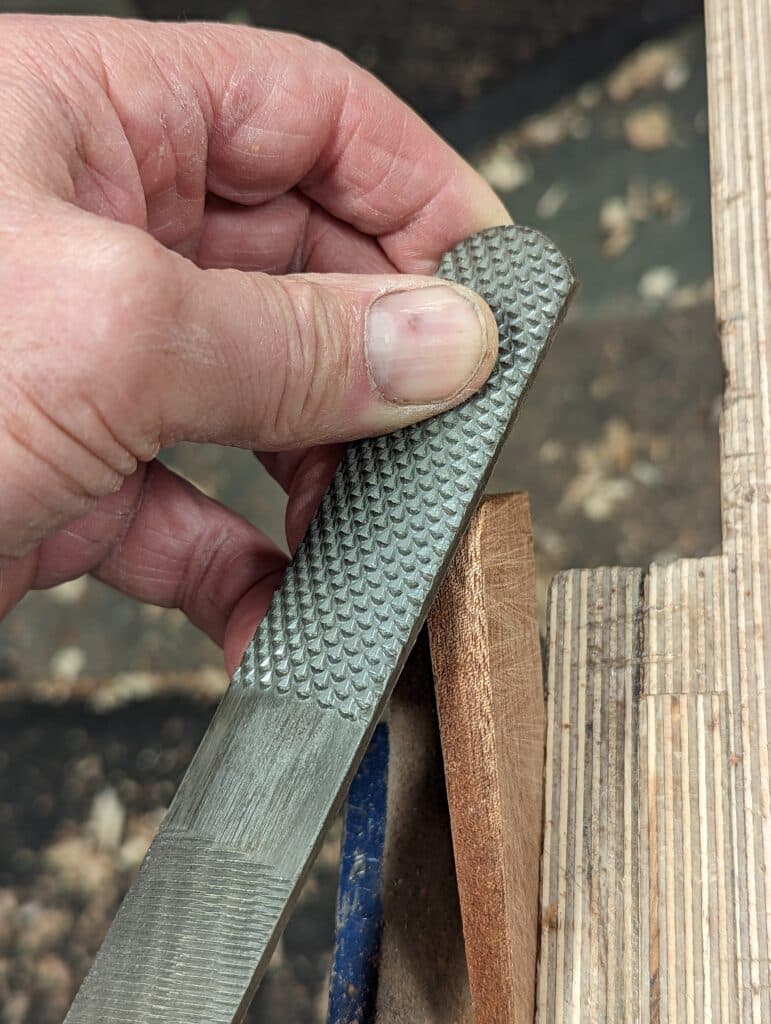
It used to be sending a brand new woodworking maker to shop for a £140 rasp that brought about me to reconsider issues. The farrier model is indisputably nonetheless a just right have compatibility for beginning your children out or in case you are best making a couple of pieces requiring shaping by means of this technique of hand paintings. Somebody achieving into the longer term for lengthy-time period shaping will now know to imagine the hand-stitched variations and there are other makers available in the market who make really nice rasps, some from puts just like the Czech Republic are actually superb and are most often more cost effective too. I personal a pair and experience them.

I purchased the Shinto noticed rasp as a substitute and feature examined it out for a just right period of time. I used one rather than my Cupboard Rasp to check out to figure out its longevity, capability and so forth. Its primary downfall is there is not any spherical face to it so it’s most commonly useable on flat and convex surfaces. Hollowing is out of the query. Its benefit is that it has each coarse and fantastic in one rasp. So far as worth is going, the cost has risen. It sort of feels it is going to value you someplace round £30-35. After a 12 months’s use, it has much less chew than the Auriou, to the purpose that I ordered its alternative. Evaluating the 13 years of use with the only 12 months of the Shinto leans against getting one-quarter the time I were given from my Auriou however my Auriou remains to be going and I choose the heft and really feel of it normally. So, my conclusion is that there actually is little distinction in total value aside from that we do have the spherical again to the Auriou and the coarse and fantastic faces of the Shinto.
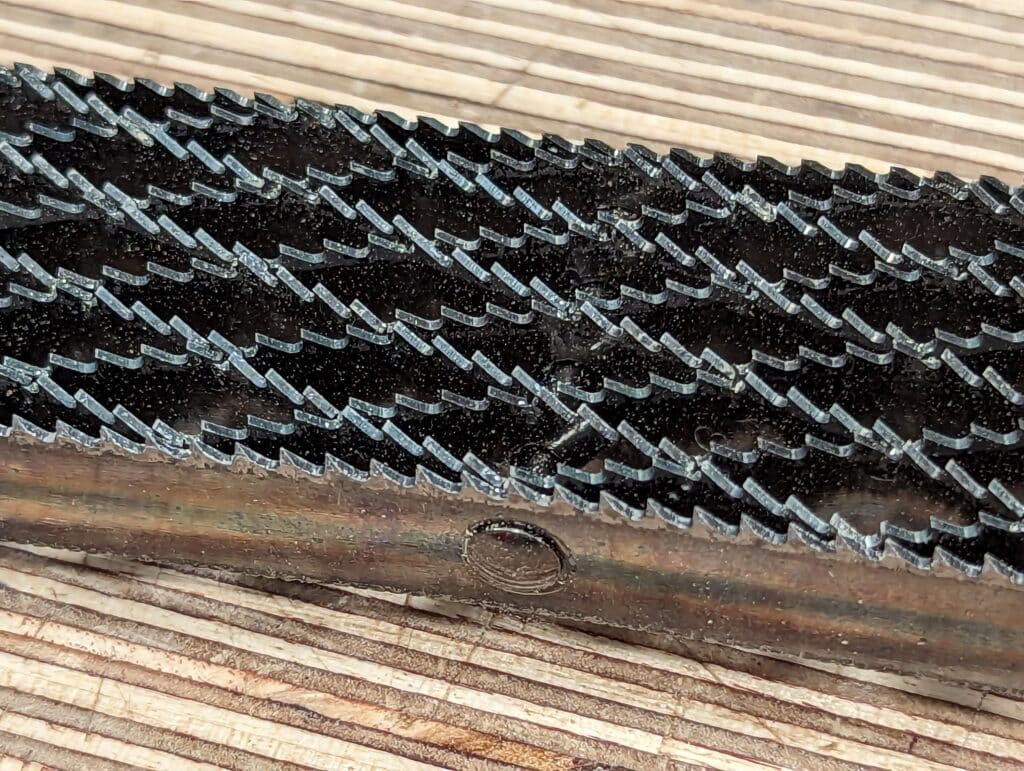
For the primary phase, I will be able to are living with out the coarse aspect of the Shinto despite the fact that I will be able to see it being very at hand every now and then for starting up subject material in amount and temporarily. What I will not are living with out is the spherical again of the Auriou or different makers I’ve. A snappy turn of the wrist to maintain hollows and rounds similarly smartly with the similar fineness. However I’m content material now that I understand it isn’t an both-or. I will be able to prolong the lifetime of my Auriou and double and even triple its longevity by means of the usage of either side of the Shinto noticed rasp.

Conclusion: After lengthy-time period checking out, I experience proudly owning each the dearer rasps and the Shinto however the 4-in-hand- meets other standards. In case you get started with the 4-in-hand you’ll lose not anything beginning out and it’s just right for kids to paintings with. Then imagine the Shinto when you suppose you’ll don’t have any want for the spherical face of a correct rasp; this can be a stepping stone to proudly owning a top class rasp. There may be true pleasure in proudly owning an Auriou and maintaining it for absolute best paintings longer term. I believe for many woodworkers with restricted time of an afternoon per week on the bench that this may turn out to be an entire life device for them
Day 4 of the out of doors kitchen island construct begins with the door and drawer entrance meeting. I’m the usage of 1/2” plywood for the panels and will want to minimize a rabbet on every panel sooner than meeting.

However first, a snappy notice on those JessEm curler guides. I really like them however haven’t been the usage of them in recent years because of laziness. Now and again I am getting in my very own approach. I’ve them, they paintings nice, and I must use them always. For those who’re no longer accustomed to them, they’ve a curler on a slight inward attitude towards the fence. The curler has grippy subject material to carry the workpiece and they just roll ahead. This very much reduces the chance for kickback. For smaller items not up to a few inches they only get in the way in which. On this case, they’re going to be useful.
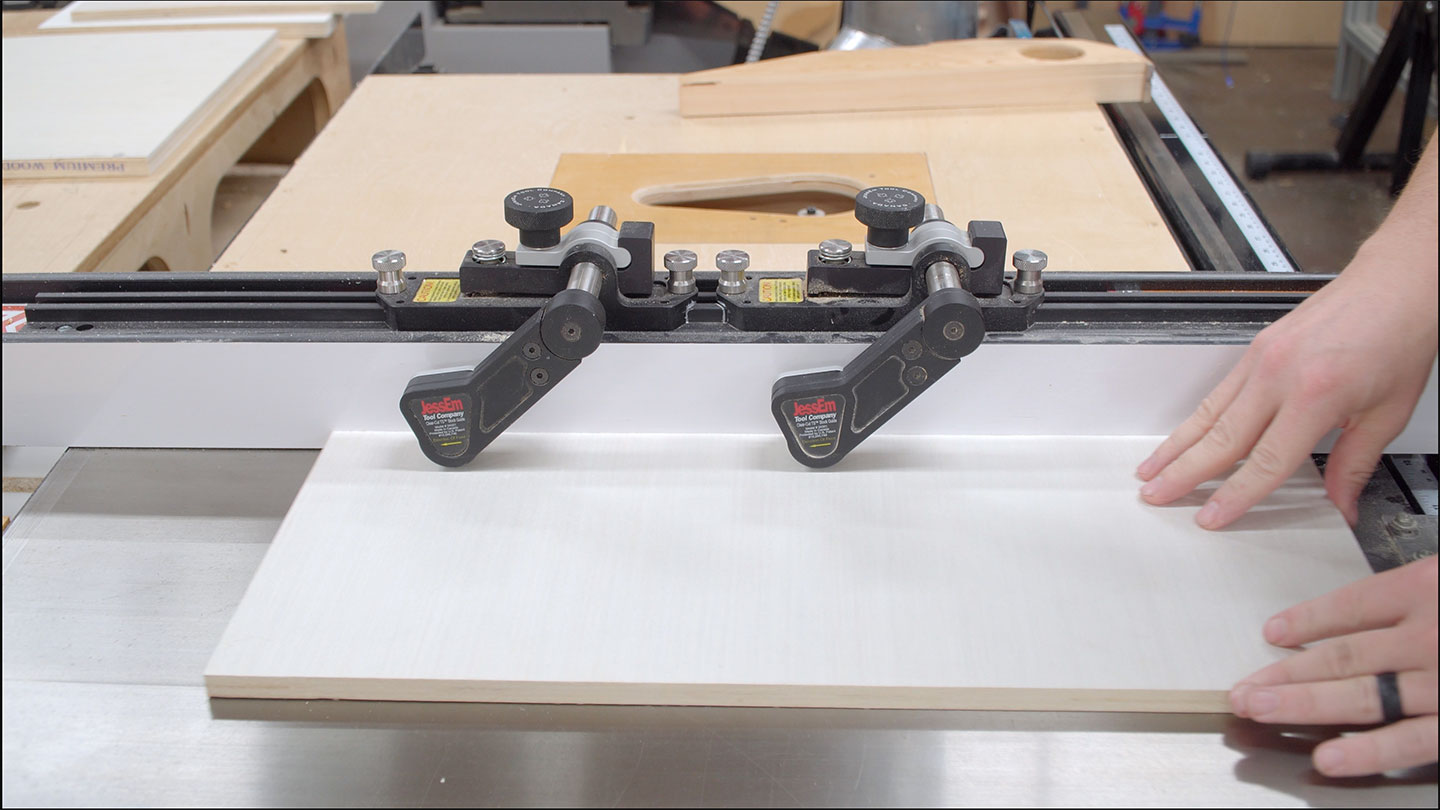
When used, I’m straight away grateful that I’ve them. It’s peculiar how some pieces I’ll move out of my approach to make use of and others I’ll have lazy moments, even making an allowance for how handy they’re.

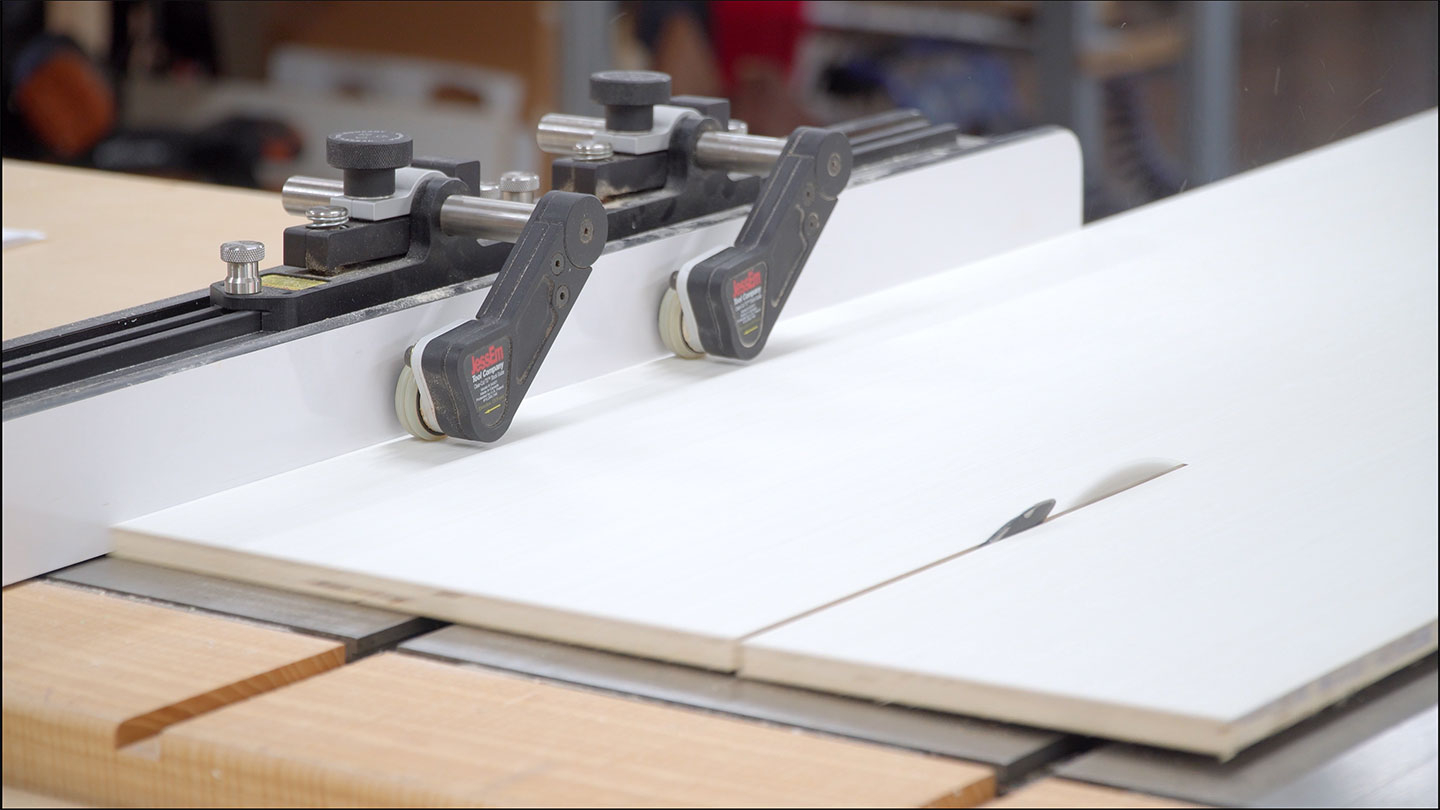
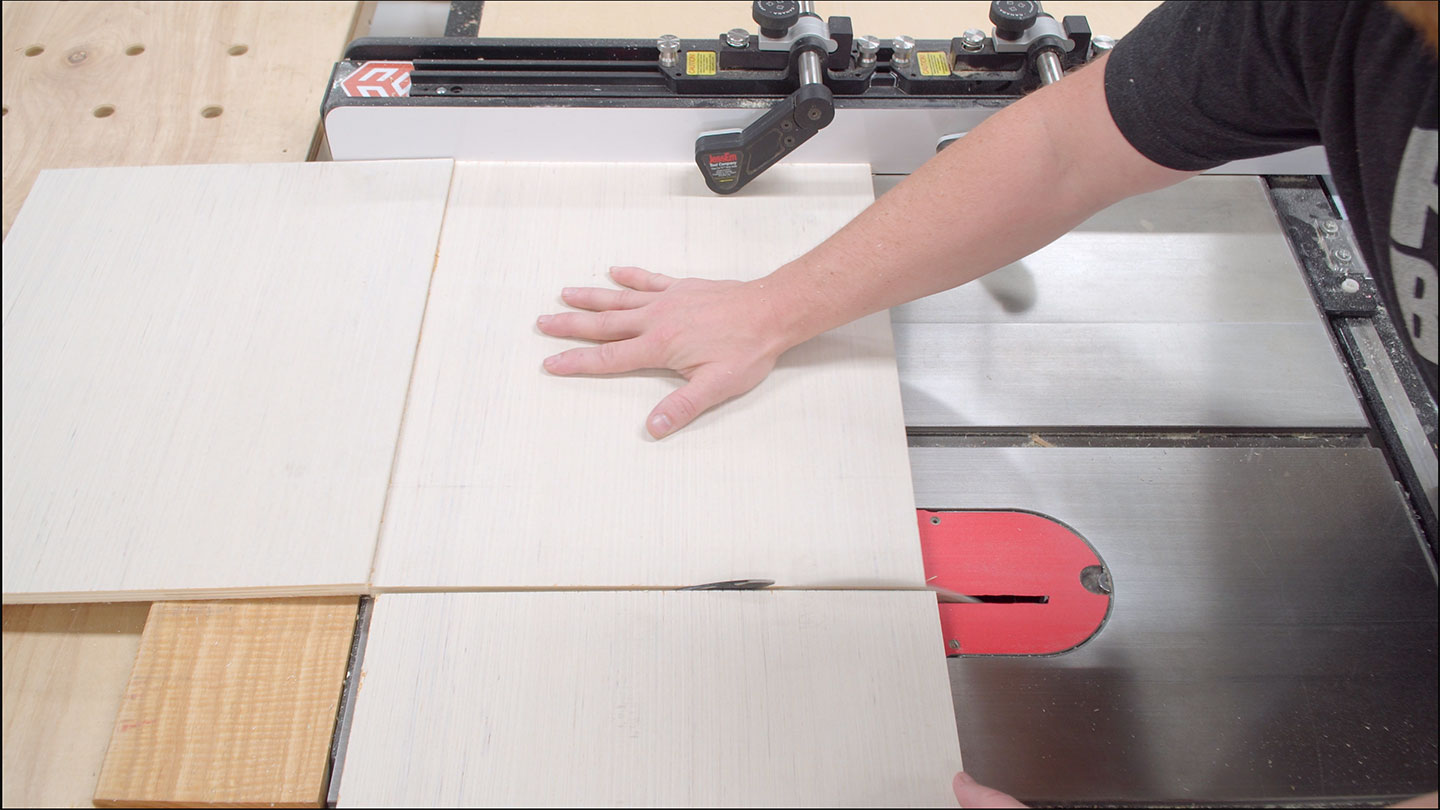
For the panel rabbets, I selected to make use of a dado stack within the desk noticed with a sacrificial fence. The sacrificial fence lets in the overall dado stack for use and buried within the fence. The fence place determines the width of the rabbet and the peak of the dado stack determines the intensity of the rabbet. As soon as dialed in, the interior face of the panel must be flush with the interior face of the door and drawer entrance frames. The entrance may have the standard 1/4” step not unusual in shaker cupboards.


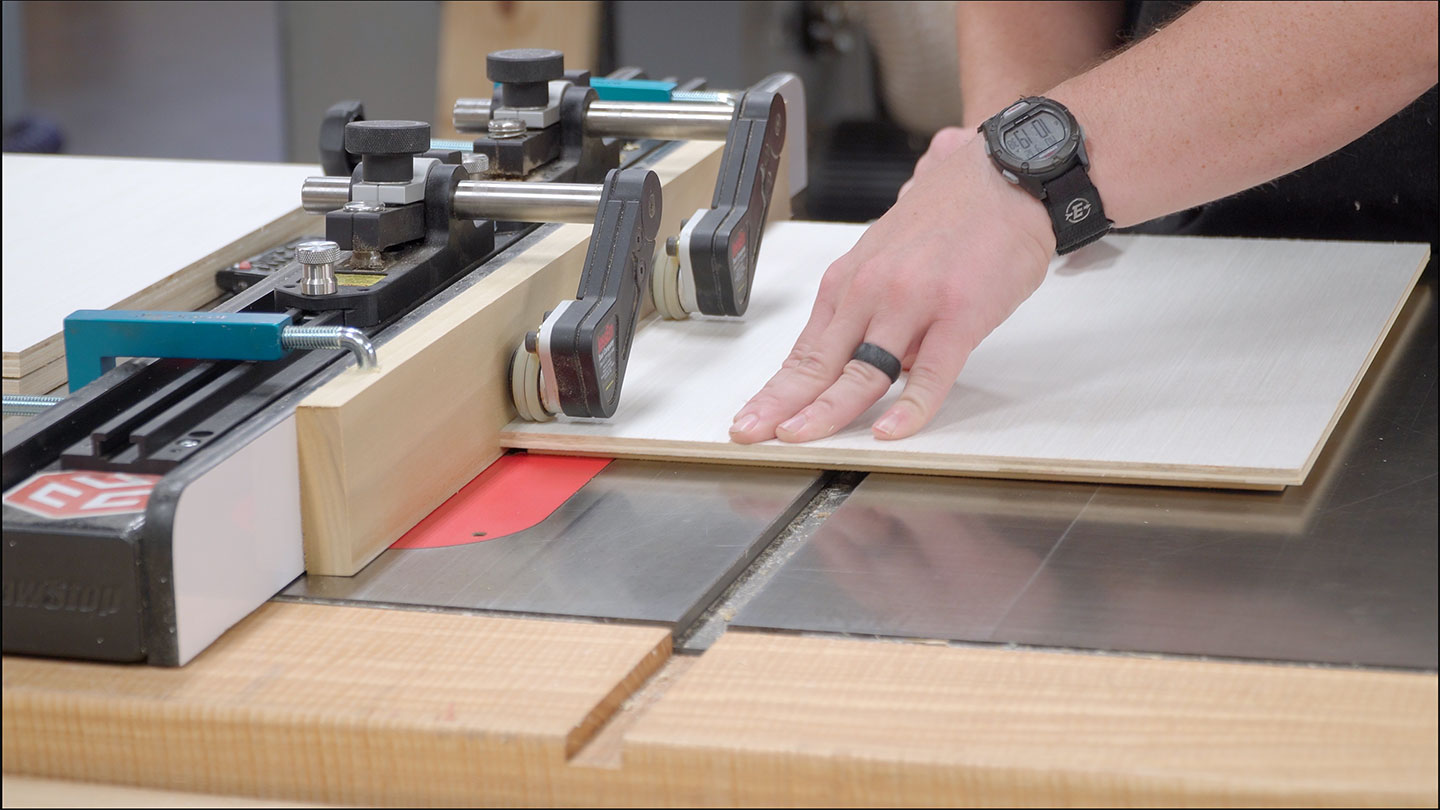
Now the doorways and drawer fronts can also be assembled. Since the panel is an engineered panel, all of the panel can also be glued in position. Little need for a spread and contraction hole right here.
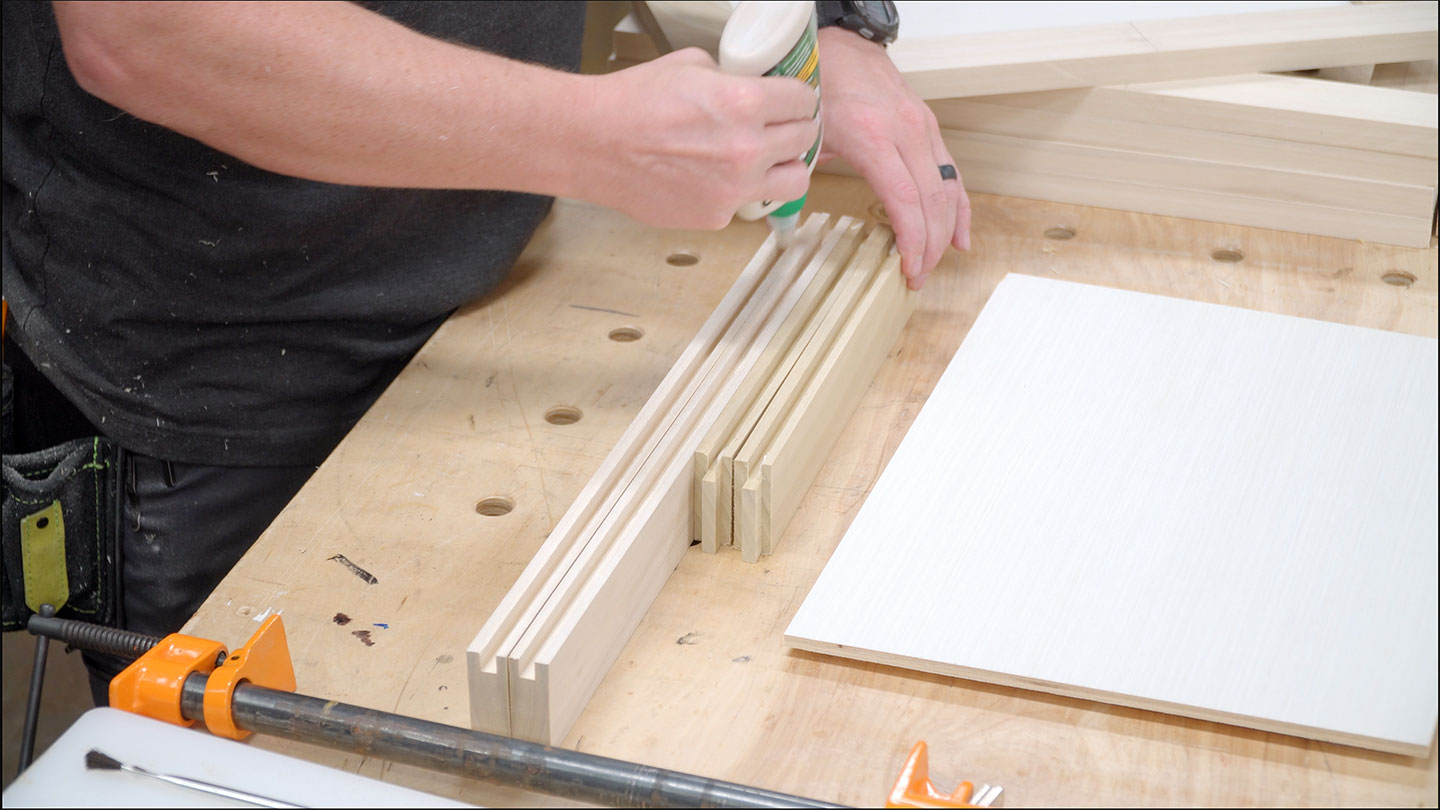
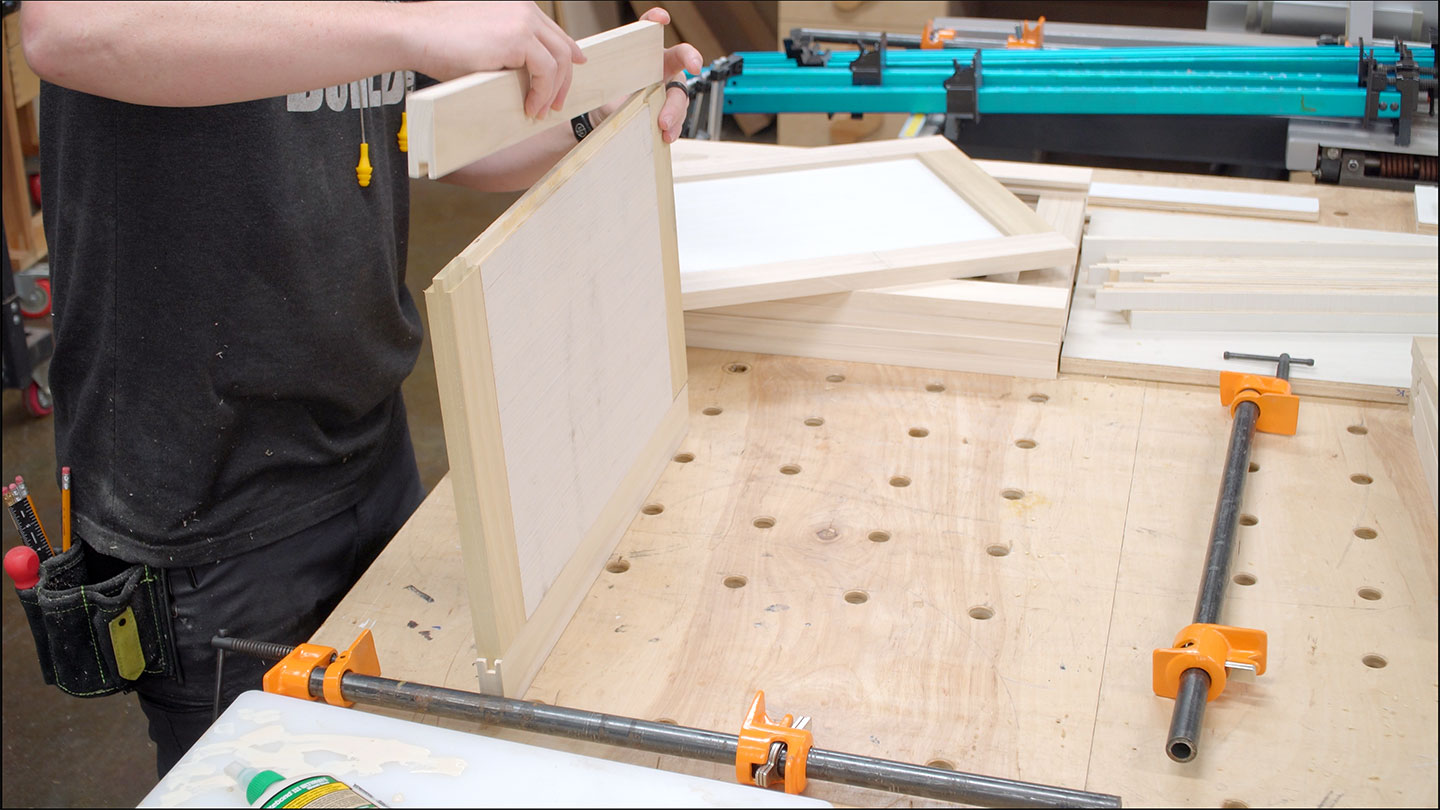
After you have the entire doorways and drawer fronts in clamps I notice why maximum cupboard stores choose to outsource their door introduction. Between milling the lumber, reducing the joiner, and assembling the doorways there may be a large number of time intake. It simply is sensible for a large number of cupboard stores to outsource this step.
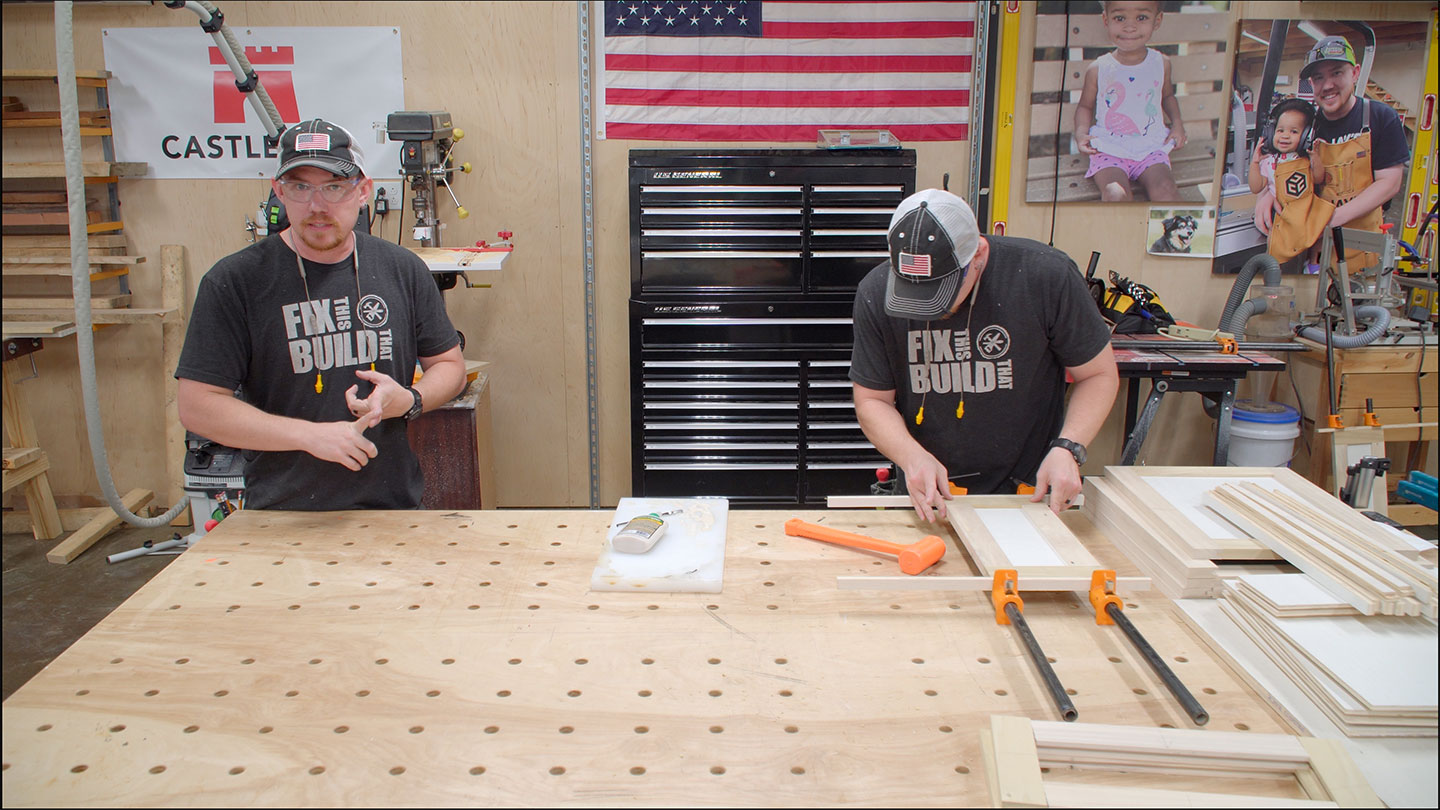
Whilst the doorways and drawer fronts are in clamps I converted to the legs. The 4 nook legs shall be sq. and the 3 inside legs shall be oblong.

The everyday milling technique of jointer > planer > miter noticed > desk noticed is adopted.
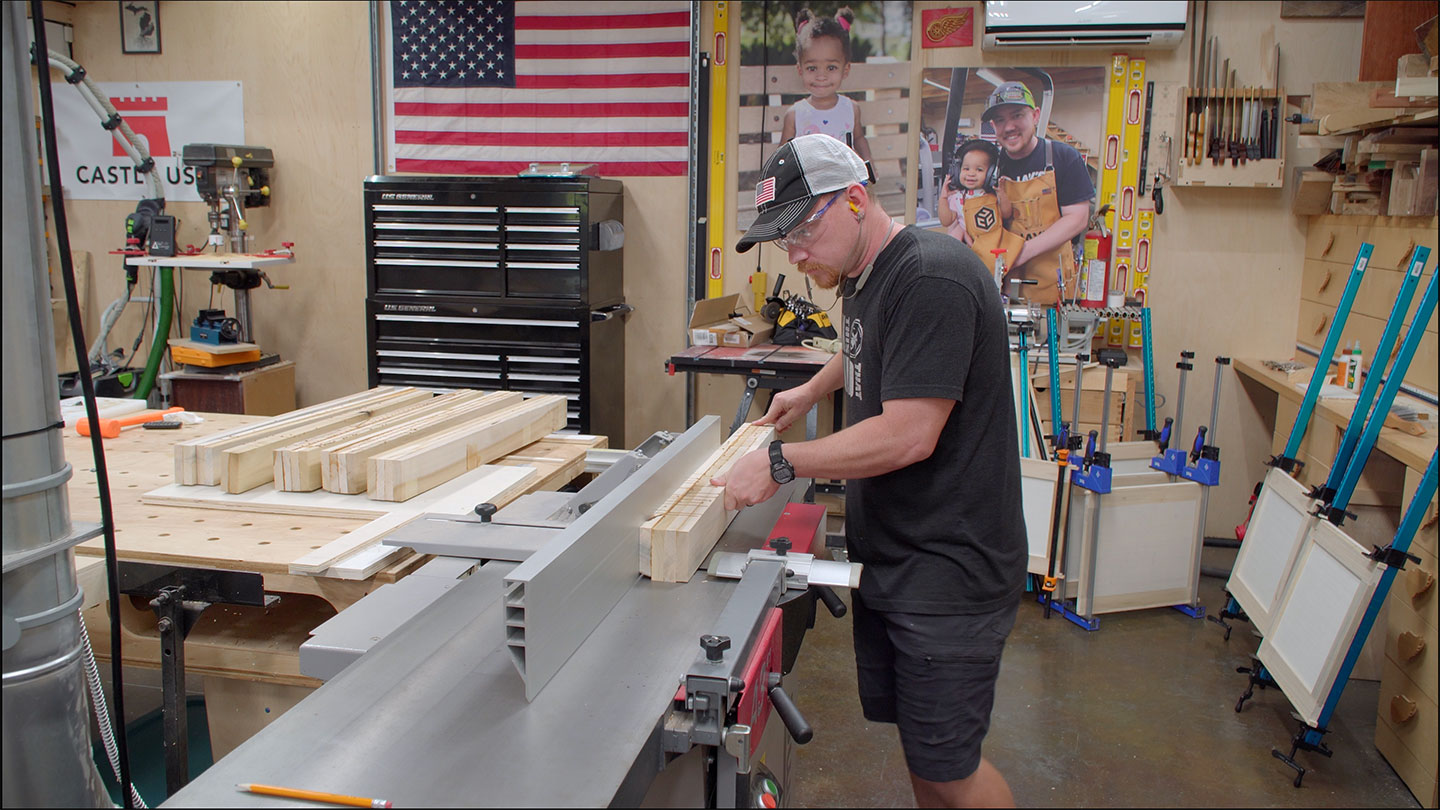
On the other hand, the desk noticed used to be handiest used for the nook leg rabbets. Those too will are compatible in position by the use of a rabbet. Two cuts on the desk noticed to create it however take into accout of the second one minimize I made. It’s generally no longer really useful to have the offcut trapped between the fence and the blade for kickback causes. If the piece has any pressure motion whilst being minimize you possibility that offcut being shot again like a missile. On this case, I didn’t see any indication of inner stresses and I extensively utilized a push stick with stay the offcut shifting ahead, previous the blade.
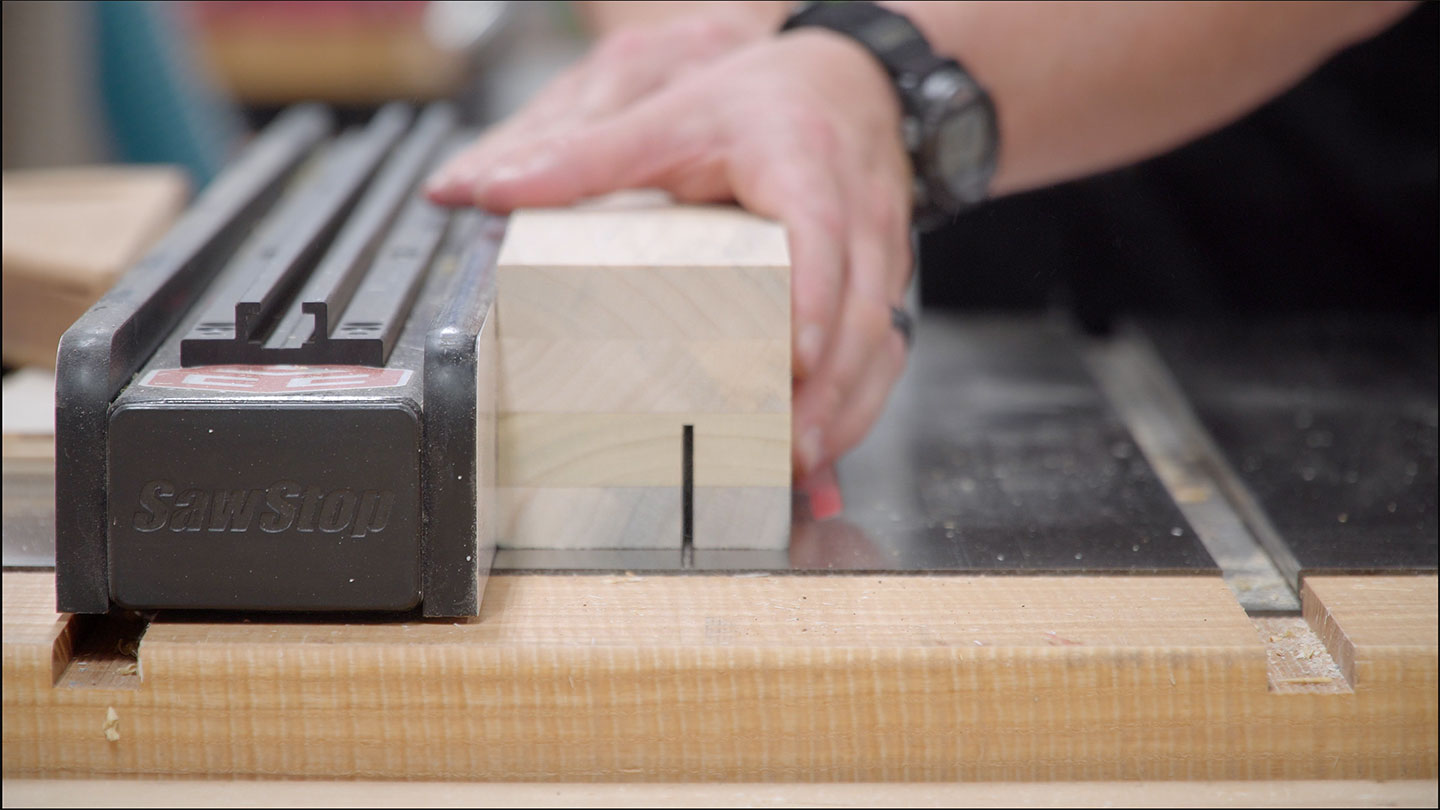
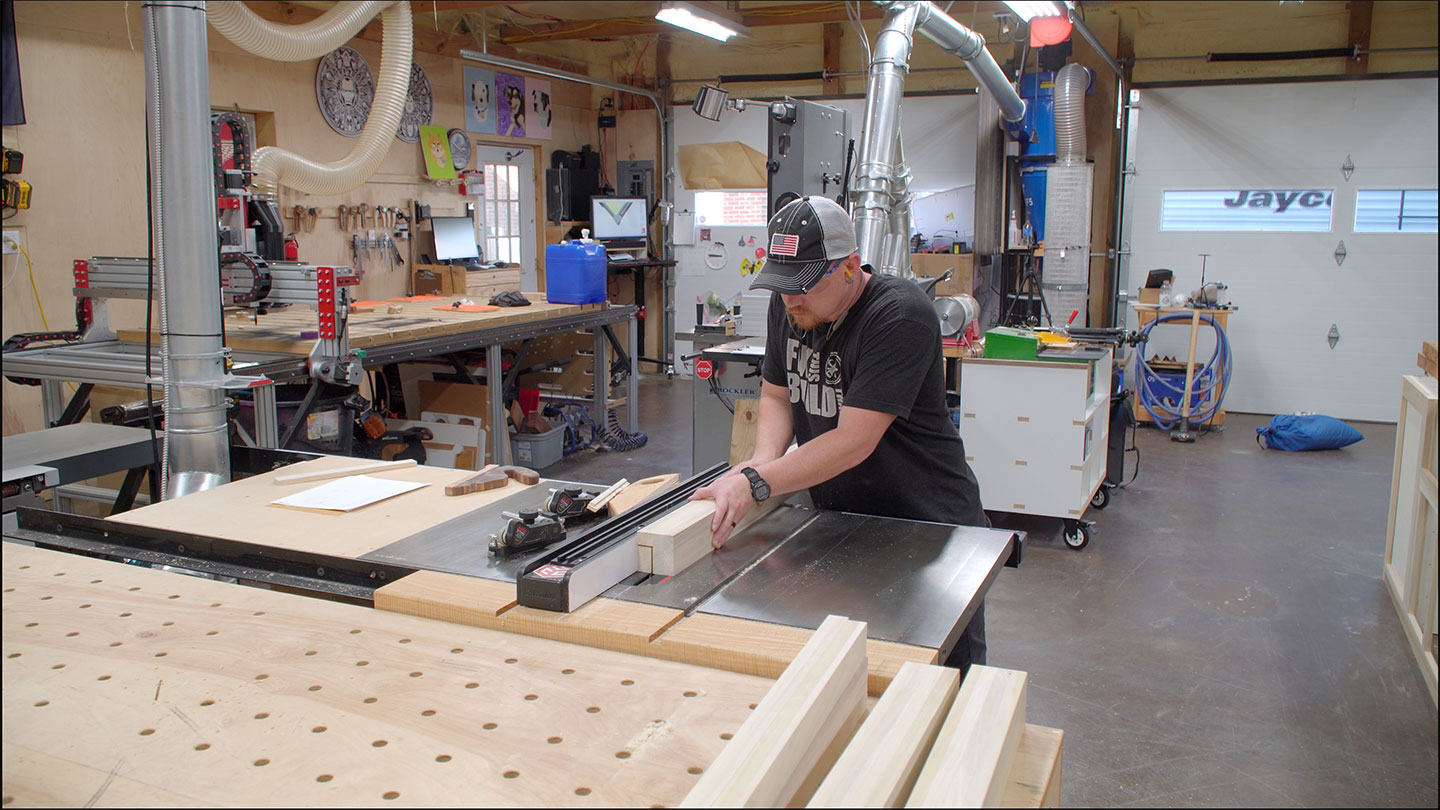

I’m the usage of the router desk so as to add a stopped chamfer element on every of the legs. The chamfer will get started and forestall a couple of inches clear of every finish of the leg so I scribed visible reference marks at the fence. It’s simple sufficient to begin and forestall at those traces through eye. No forestall block gadget is vital.
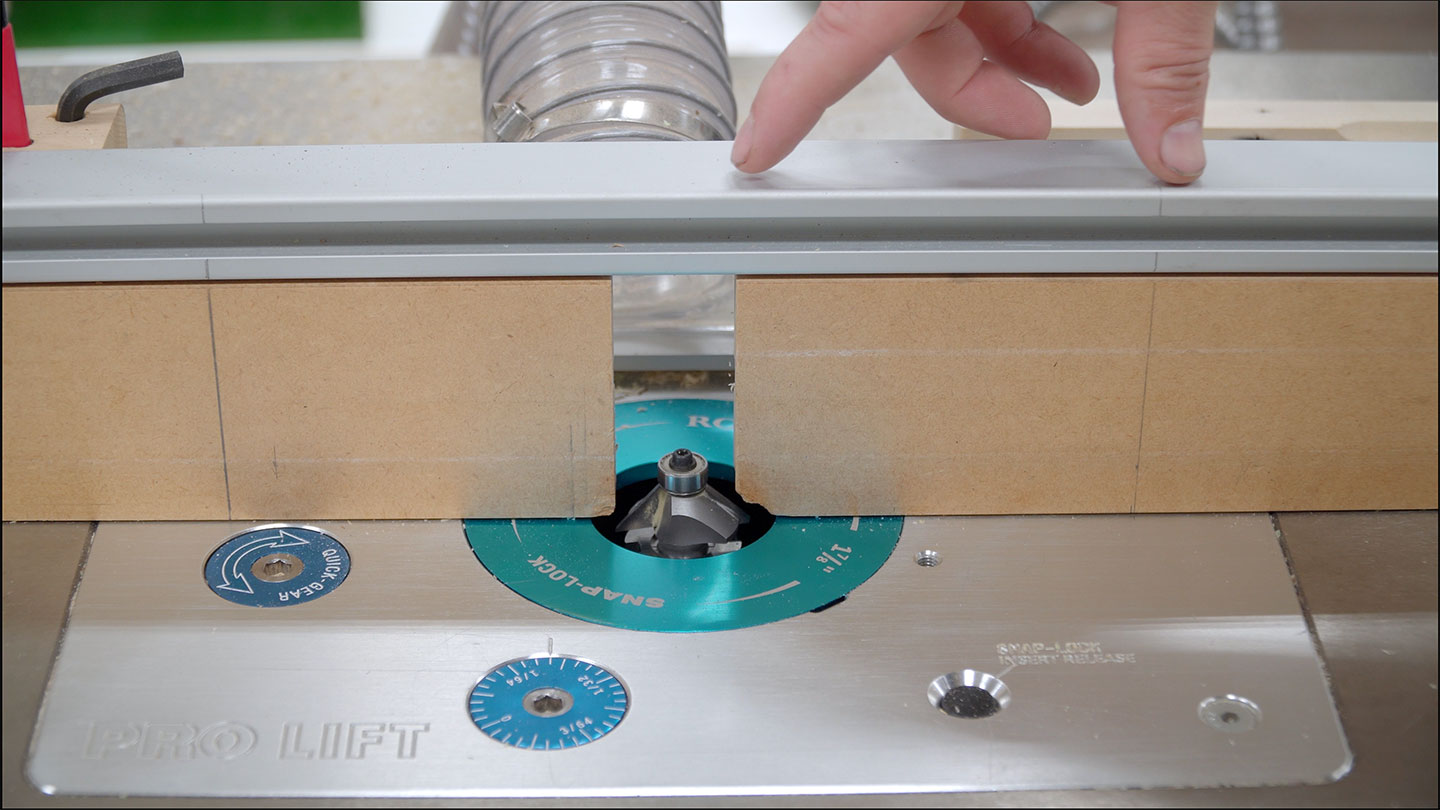

Throughout the chamfering procedure, I had an oopsie! The mud assortment at the router desk pulled some of the legs into the bit after I didn’t need it to. This gouge must be patched certainly one of two techniques. If this had been a transparent end piece I’d course a rabbet into the brink to totally get rid of the oopsie. Then glue a grain matching piece in position, flush it with each huge faces, then recreate the chamfer forestall location. Fortuitously, it is a painted piece so filling this with Bondo or one thing identical shall be more uncomplicated and simply as applicable.

The nook legs shall be secured with glue and a couple of screws in the course of the inside of the cupboard.
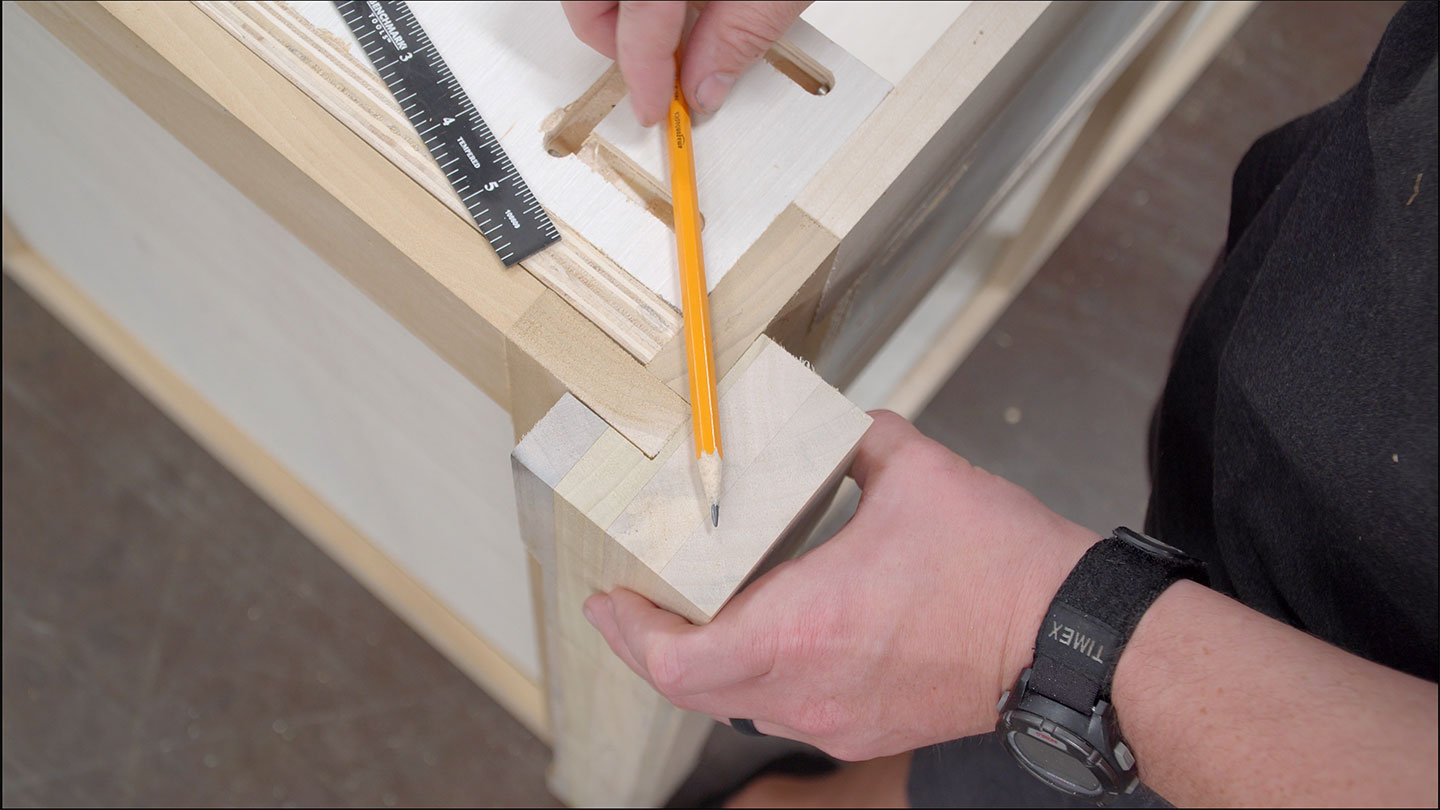
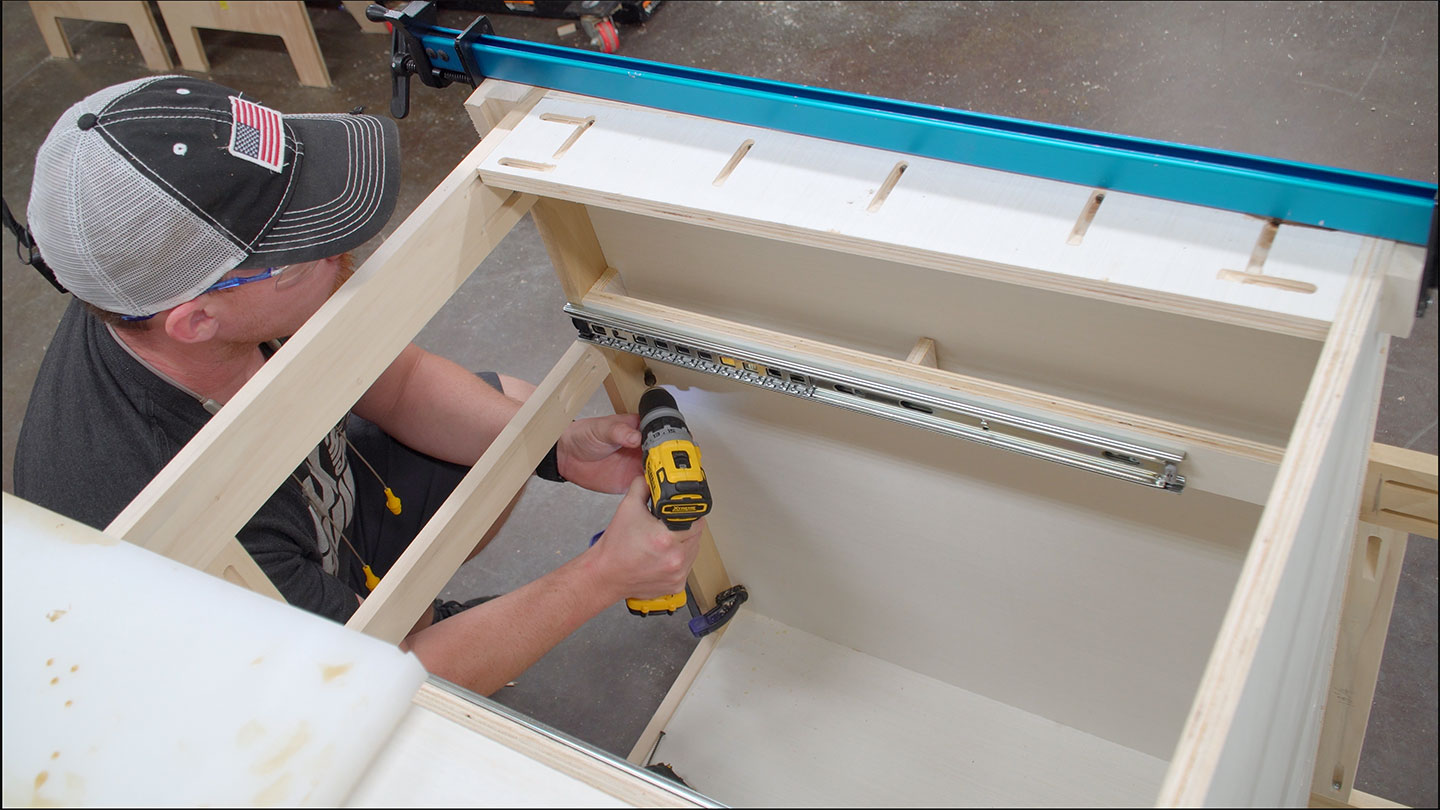
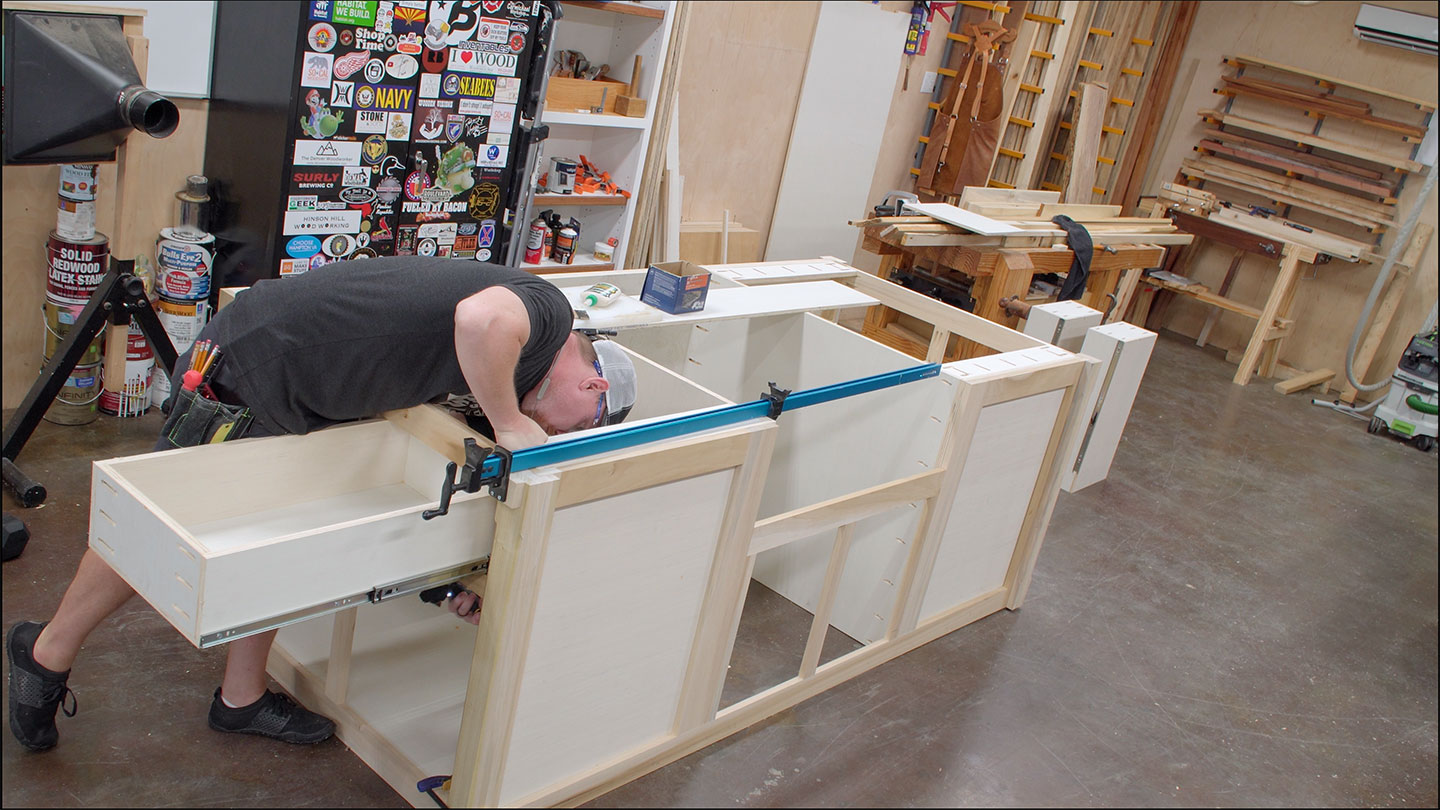
It’s time for the hinges. Those 1/2” overlay Blum comfortable shut hinges are my go-to for overlay doorways. They’re affordable and tremendous simple to enforce. I’m appearing this section on the drill press in the beginning as a result of that in point of fact is the quickest method to make the cup hinge holes.

On the other hand, I couldn’t to find the right Forstner bit for the duty so I opted to make use of my CNC as an alternative. My setup is to just minimize one hinge hollow at a time. If I had been to create a program for each cup hinges I’d want a new program for every door of a special top. As a substitute, I made a program that has one hollow minimize on two doorways on the similar time. One is the highest hollow and the opposite is the ground hollow. By means of operating the minimize as soon as, switching the doorways, and operating the minimize a 2d time I’ll have all of my cup hinge holes minimize the similar distance clear of the highest and backside in the entire doorways irrespective of top.
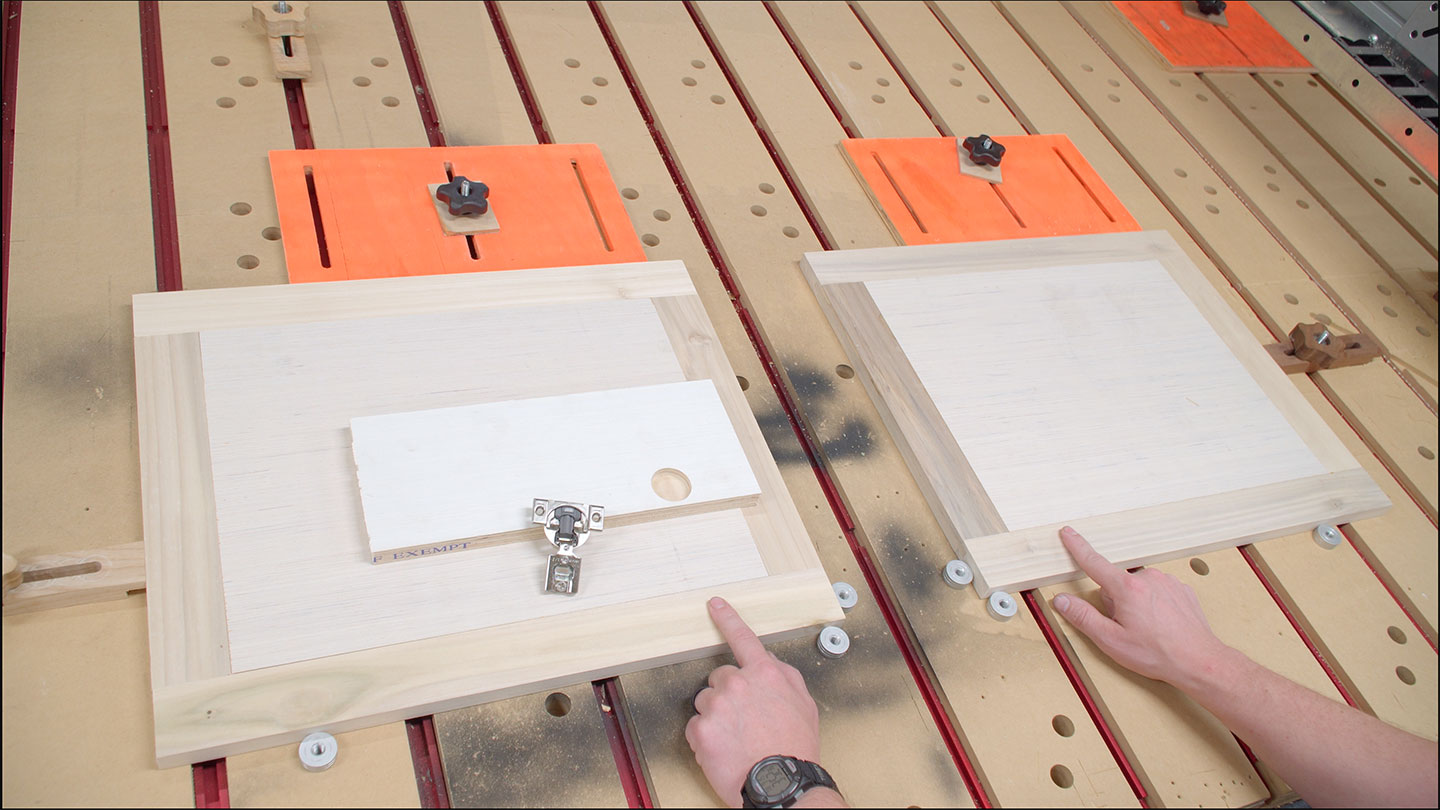

Pop the hinges in position and upload the small screws to protected them. Relying at the picket species, pilot holes could also be required. Poplar is reasonably comfortable so I opted to not make the pilot holes.
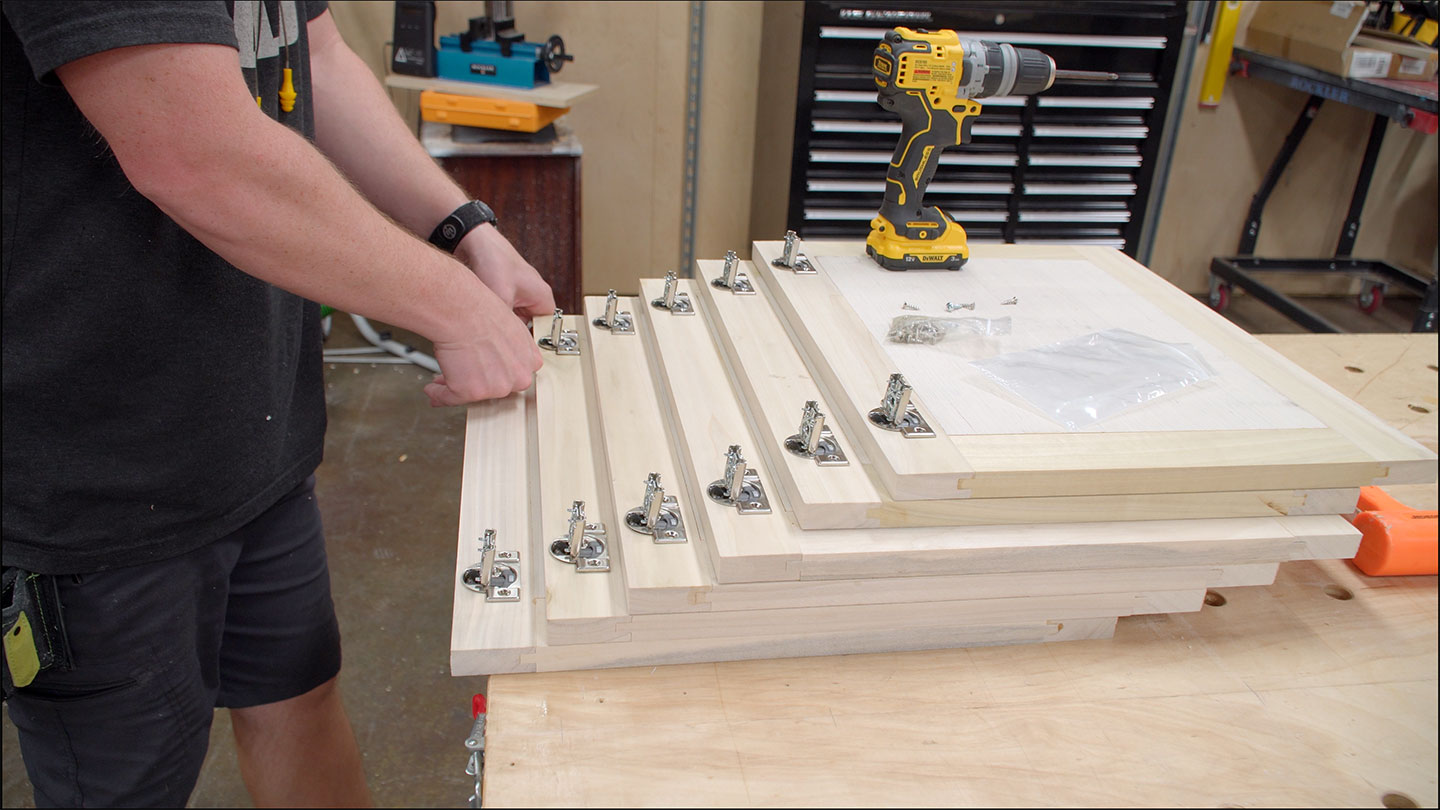

One ultimate step sooner than putting in the doorways and drawer fronts is to flush the fringe. A hand aircraft in a workbench vise gets the task accomplished simply superb however I opted to make use of my belt sander. This is among the maximum used machines in my store that will get reasonably little airtime. It’s extremely at hand for lots of duties out of doors of woodworking as neatly.
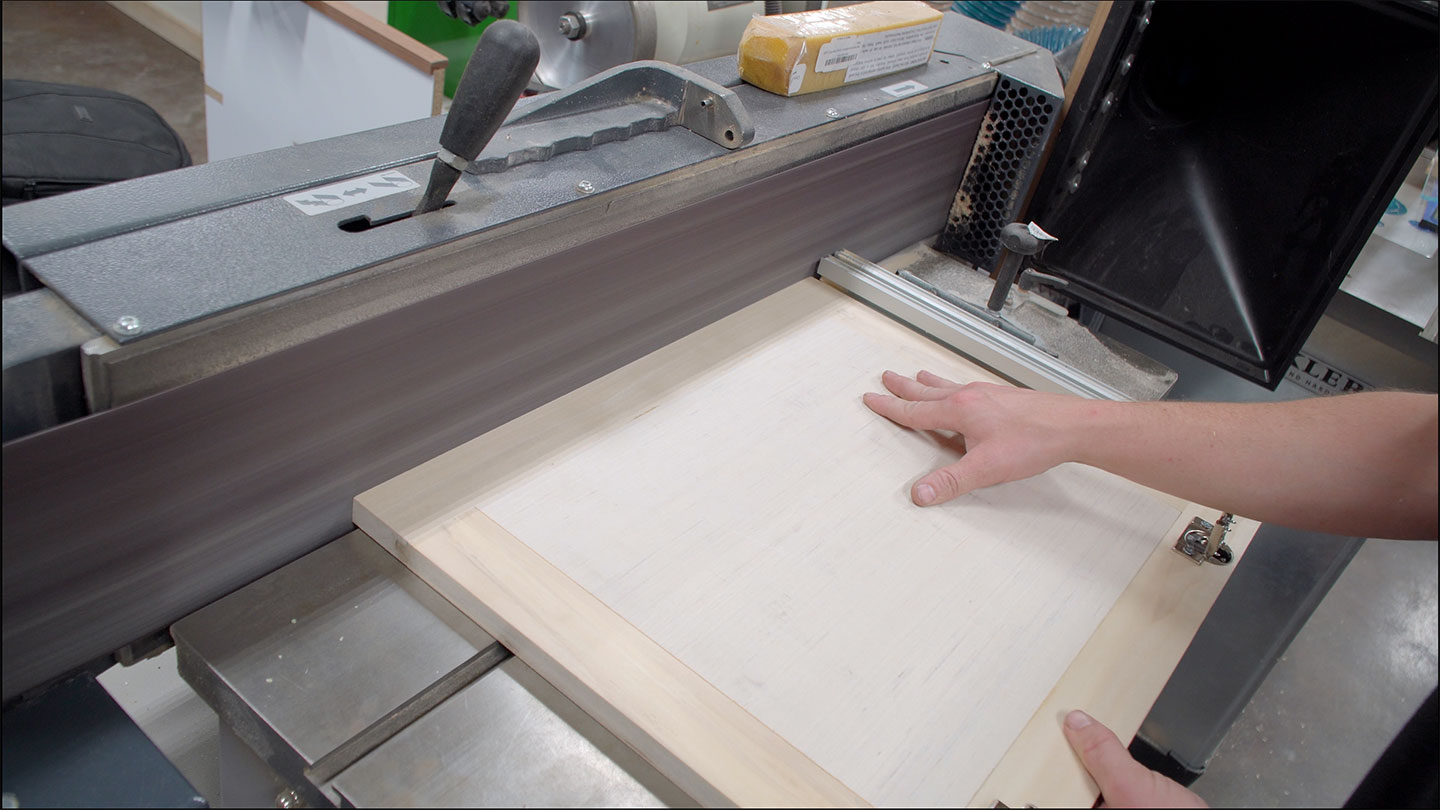
The hinges used are 1/2” overlay hinges. Because of this when put in at the face frames they’re going to overlay the face body through 1/2” when closed. The one alignment wanted through the installer is to verify the peak is about for the highest and backside 1/2” overlay. One of the best ways to try this is with a forestall block clamped to the cupboard someplace. I generally put the forestall block at the backside in order that gravity works for your prefer. On the other hand, the space between the highest of the door and the ground of the drawer is what is going to be maximum noticeable so I opted to position the forestall block on most sensible. From right here, I will be able to use my foot to raise the door whilst I take advantage of my palms to carry the door and protected it with screws.

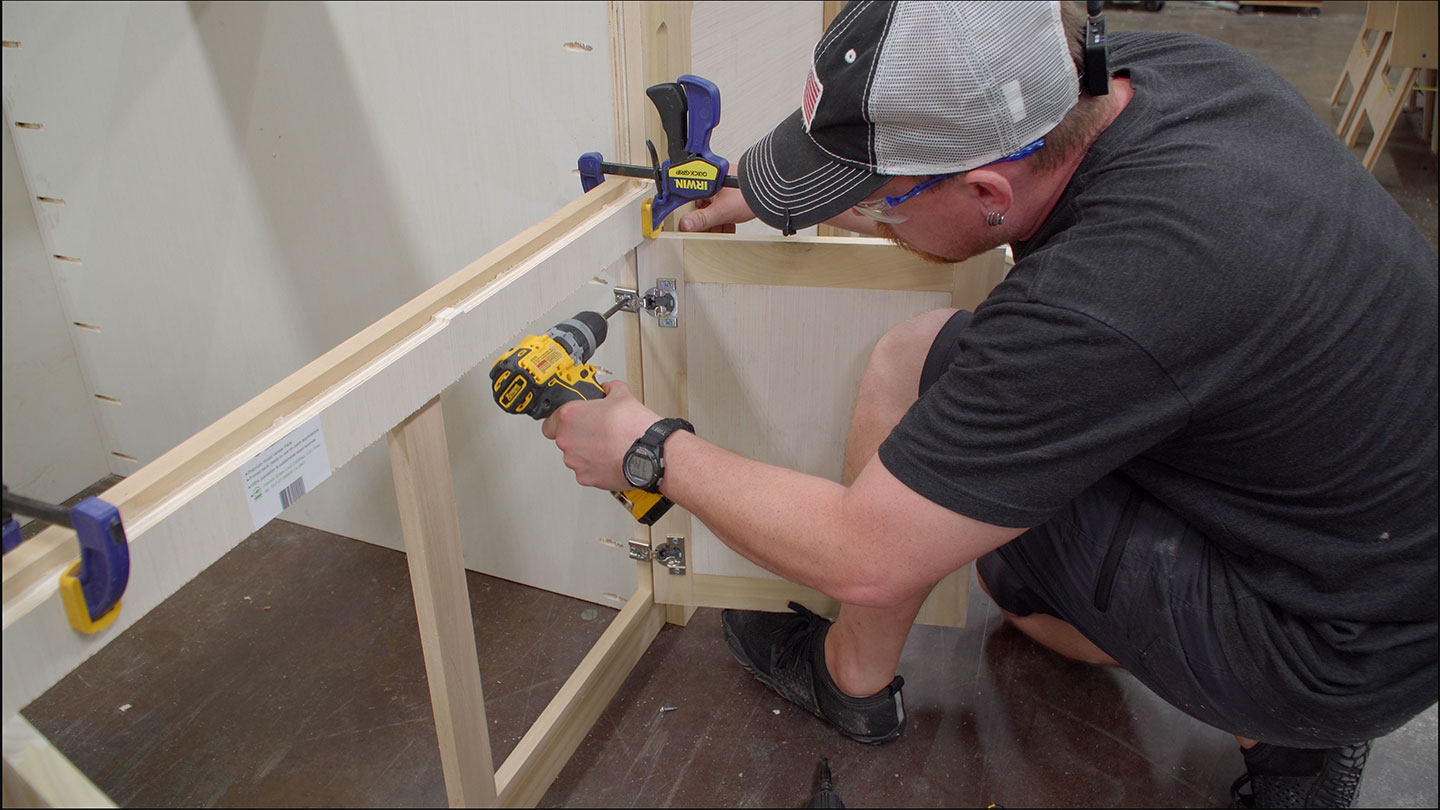
The drawer fronts are even more uncomplicated. The forestall block rests on most sensible of the doorways, pilot holes are drilled, and a couple of screws added from the interior of the drawer cling the drawer entrance in position. Those doorways and drawers will in the end get pulls that fit the countertop.
(*4*)
And that’s it for day 4 of development in this construct. All that’s left to do is somewhat little bit of fundamental trim paintings to the entrance and again plywood panels, the middle sink fortify, and the leveling ft. I’ll be completing the bottom with milk paint however will cling off on that till I am getting the matching farm desk constructed. That approach I will be able to spray them each on the similar time.
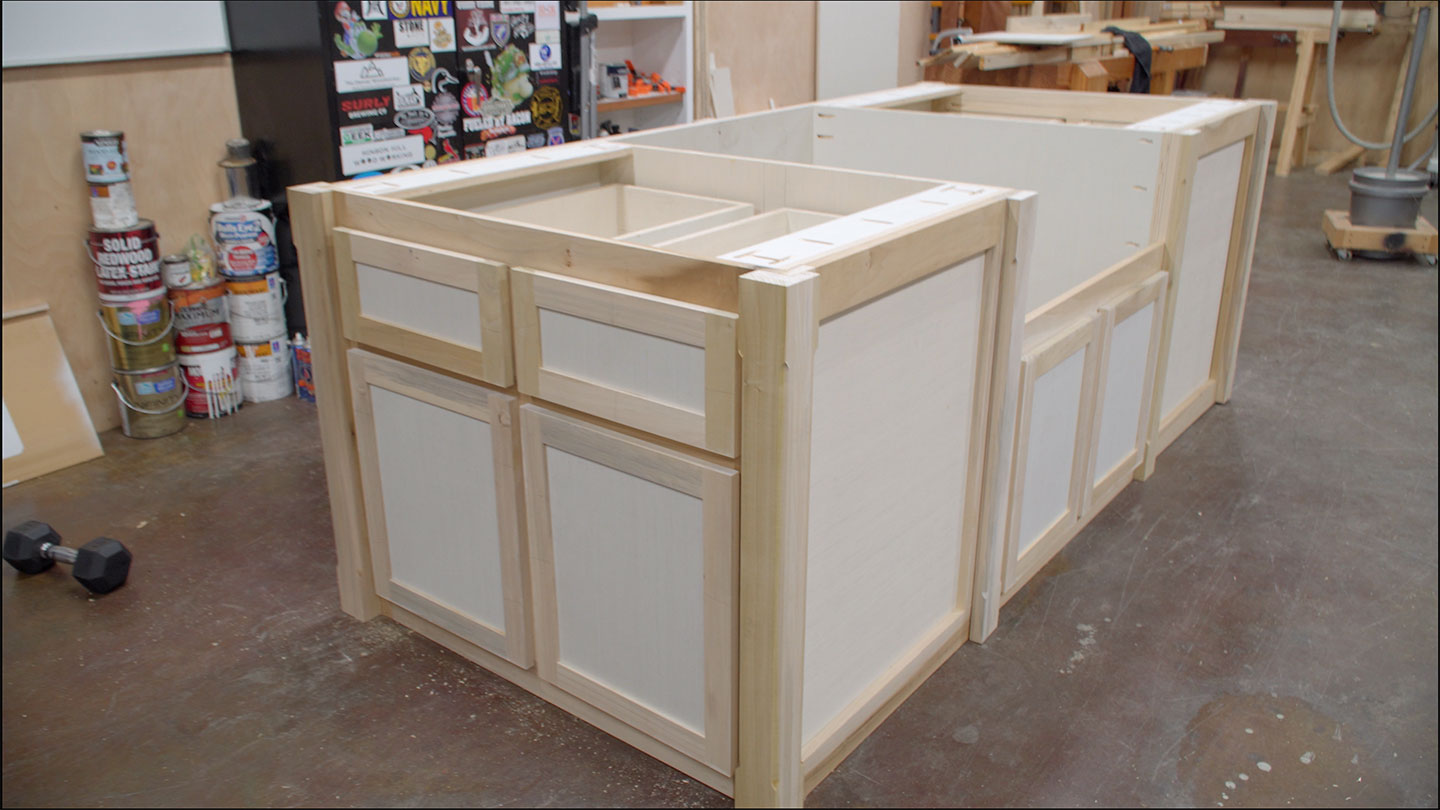
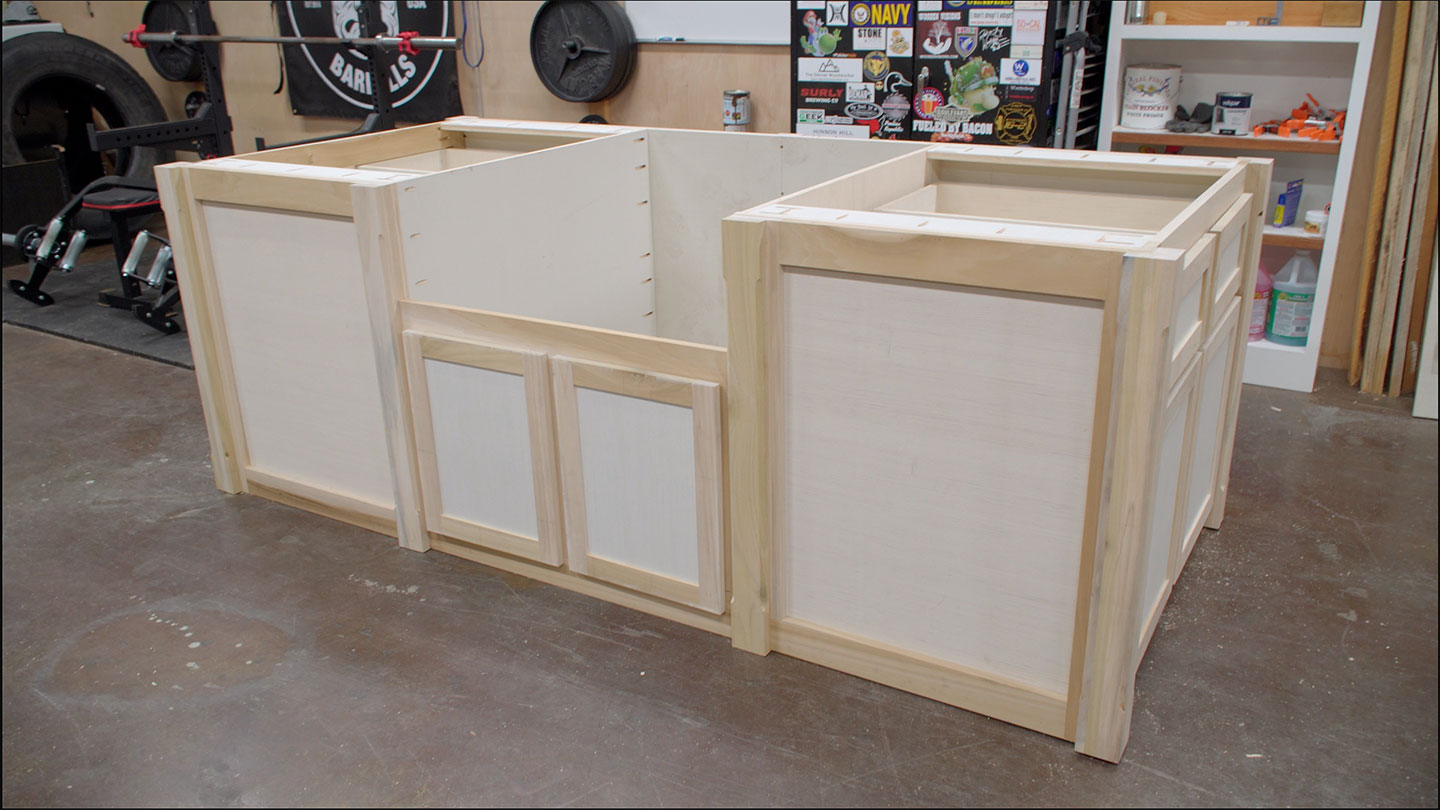
I like that this bench is comprised of simply 5 2x4s.
I like that you’ll make the matching desk from 2x4s.
I like that you’ll adapt this desk and bench set for external use.
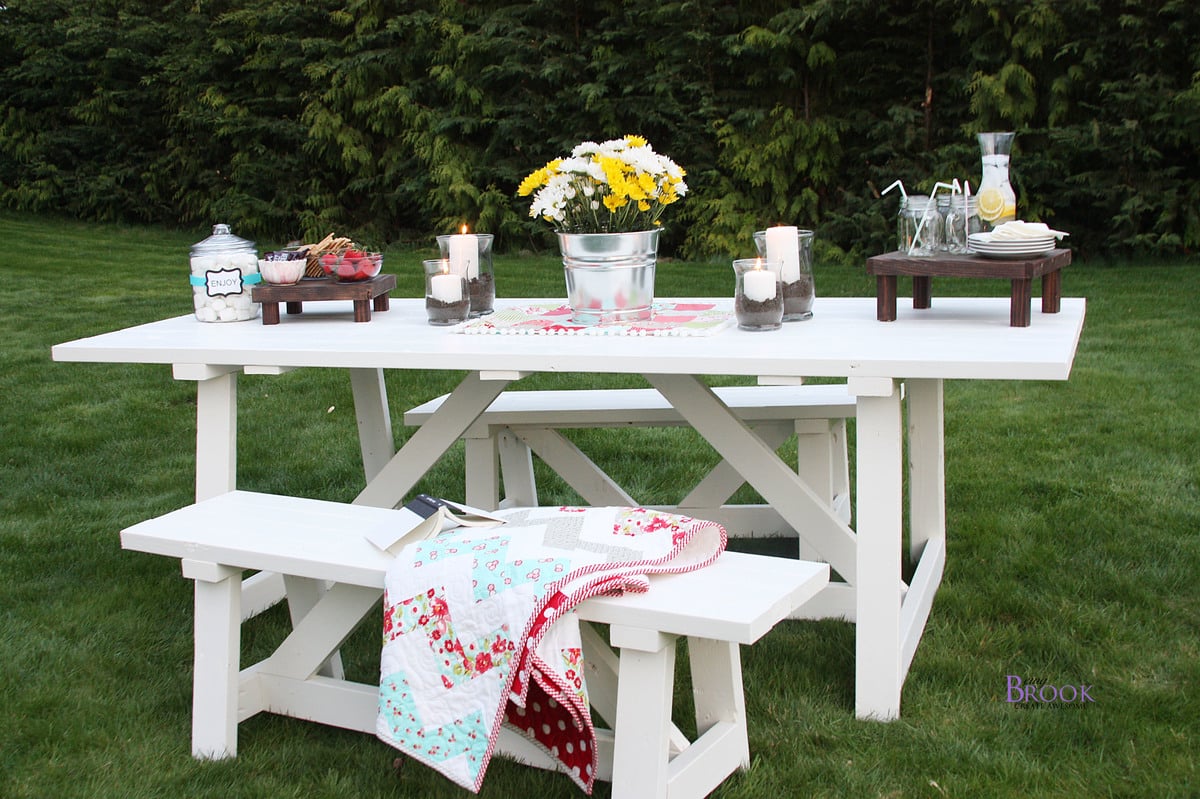
This mission was once constructed by means of Being Brook. Thanks Brook for running with me in this set. I am hoping you loved this plan and forestall over and spot so much extra pictures and pointers from Brook right here.
PS – Brook has an academic at the mini serving stands right here.
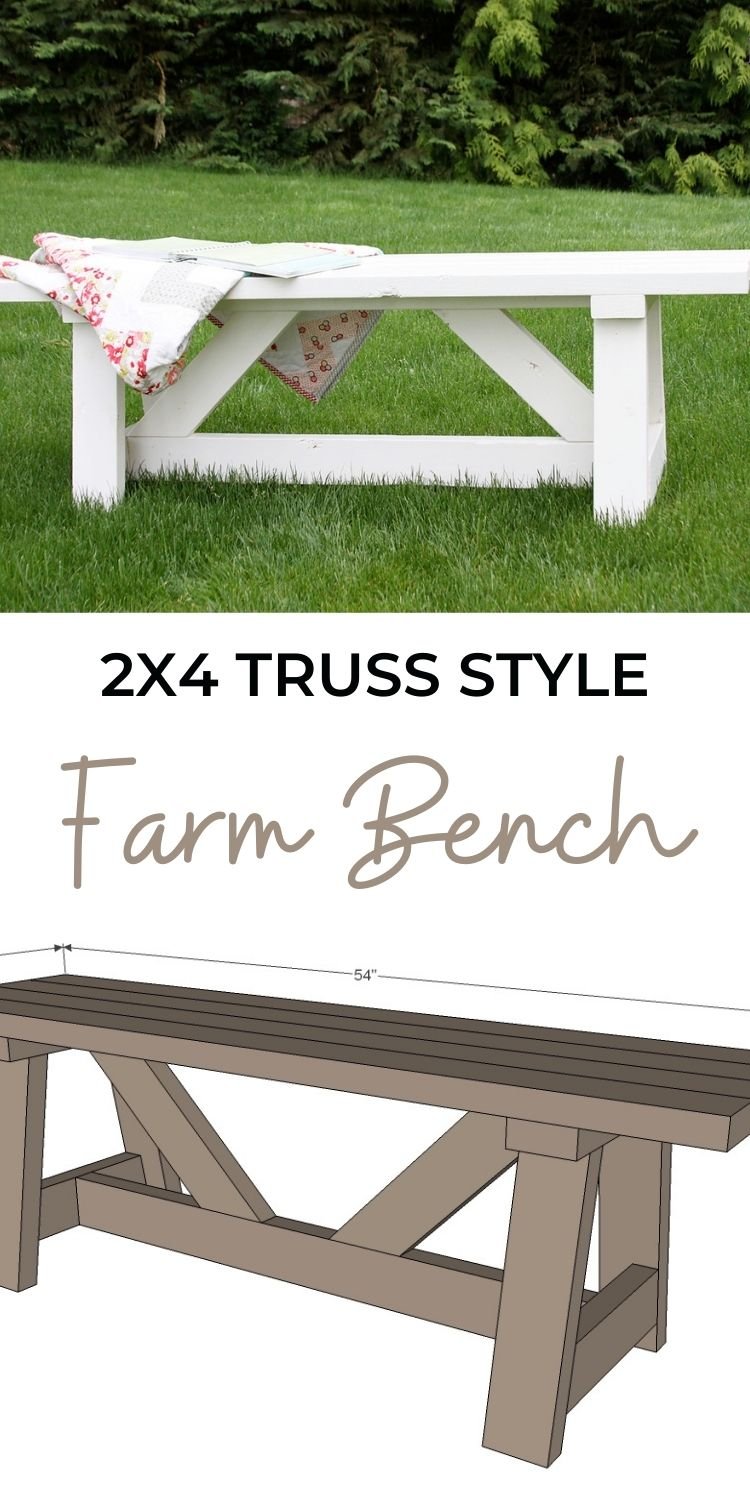
Once I first of all designed our out of doors kitchen and patio house, I incorporated a farm desk that might fit the sink island. On this video, I’ll quilt the bottom development and display a joinery means that doesn’t require clamps; sliding dovetails. The sink island and farm desk may have an identical base and an identical most sensible. All the base for this desk might be constituted of 8/4 poplar.
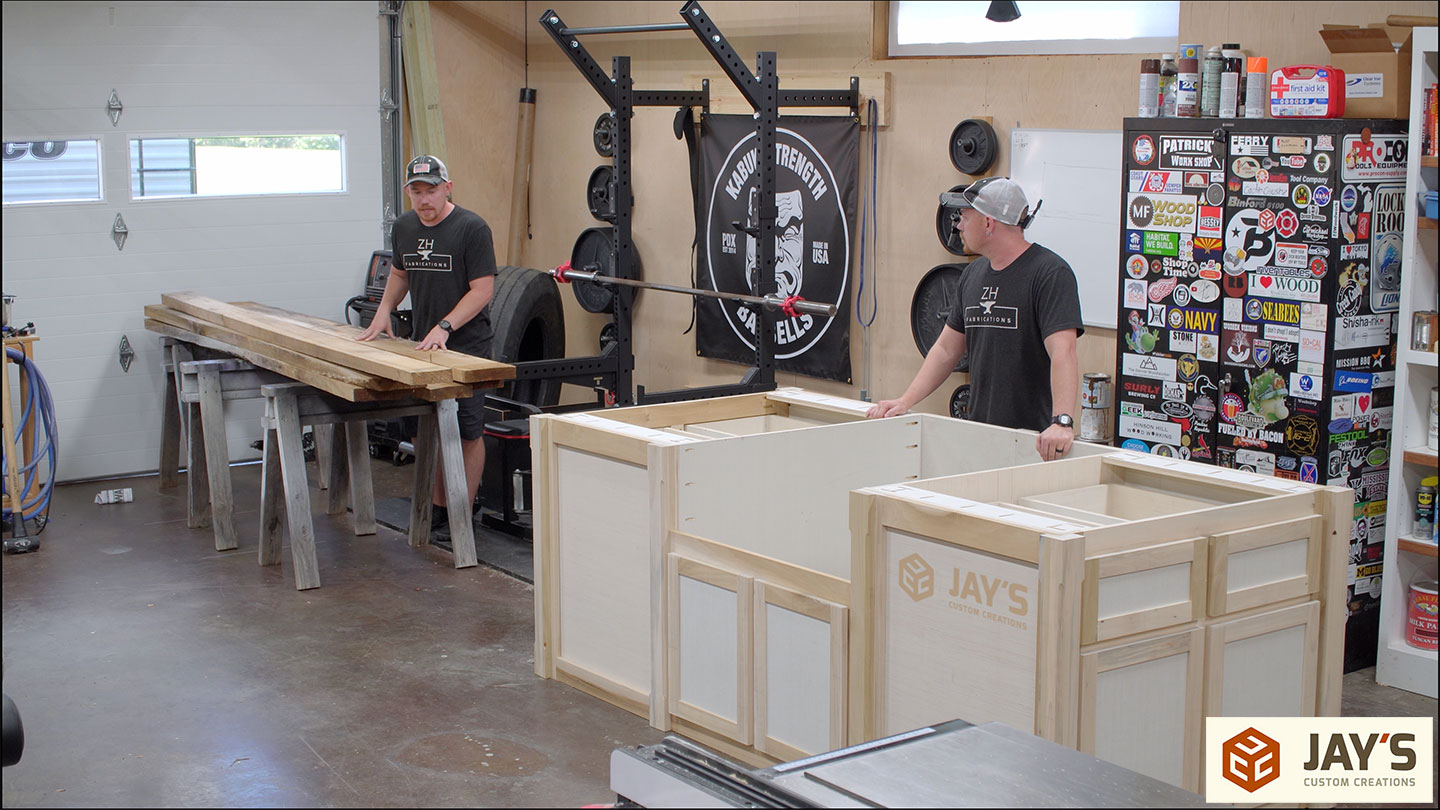
The shortest items are the legs, and to lead them to, I’m beginning with the forums that experience essentially the most bow and twist. Have in mind, the extra warped the board, the extra subject matter might be got rid of when knocking down. That is extra exaggerated the longer the board is. You’ll be able to cheat this a bit bit by way of making the forums shorter sooner than milling them.
With that during thoughts, I can cut up essentially the most warped forums for the legs. First up, crosscutting to fairly outsized leg blanks.
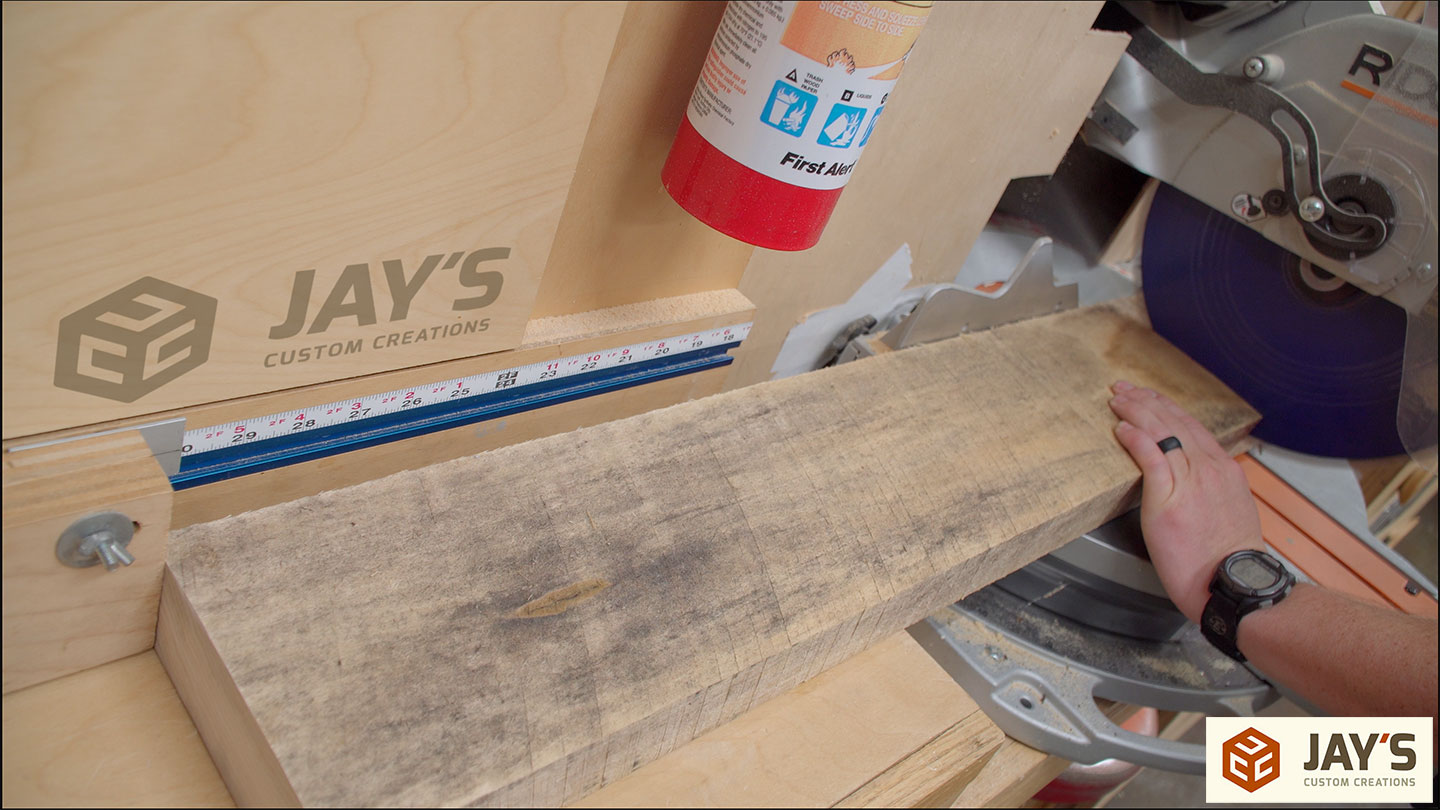
Jointing two faces flat and sq. on the jointer.
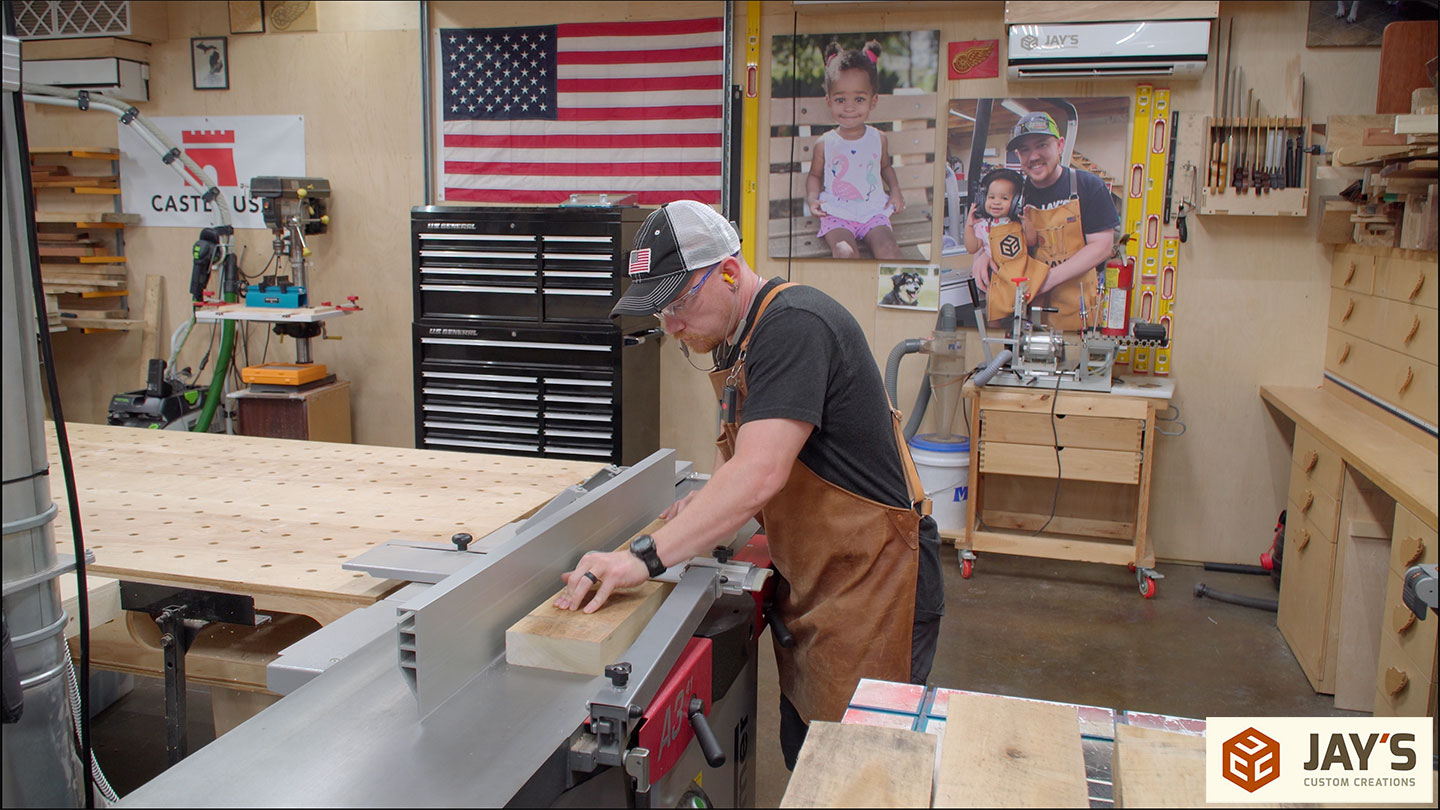
And planing to most thickness on the planer. The thicker those finally end up, the simpler.
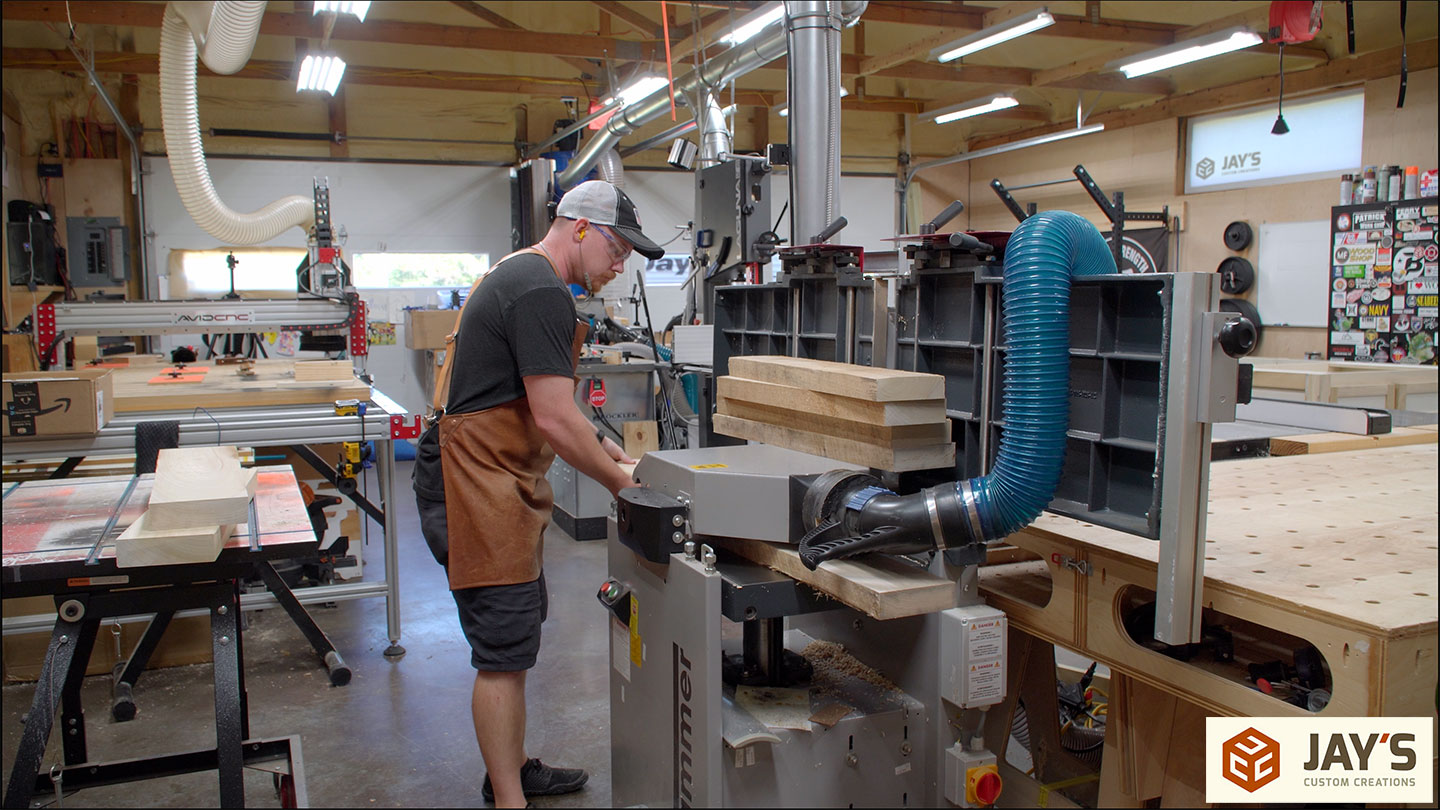
Right here’s a perfect tip I will cross alongside to you. I discovered this concept whilst staring at MTM Wooden on YouTube after which made my very own video at the matter. Take two 3” PVC pipes and safe some flat inventory to the ground to stop them from rolling round. Now you’ve gotten an affordable and GREAT glue-up platform. This permits you to get clamps on most sensible and backside with out flipping. Then again, I nonetheless turn the glue up if I will.
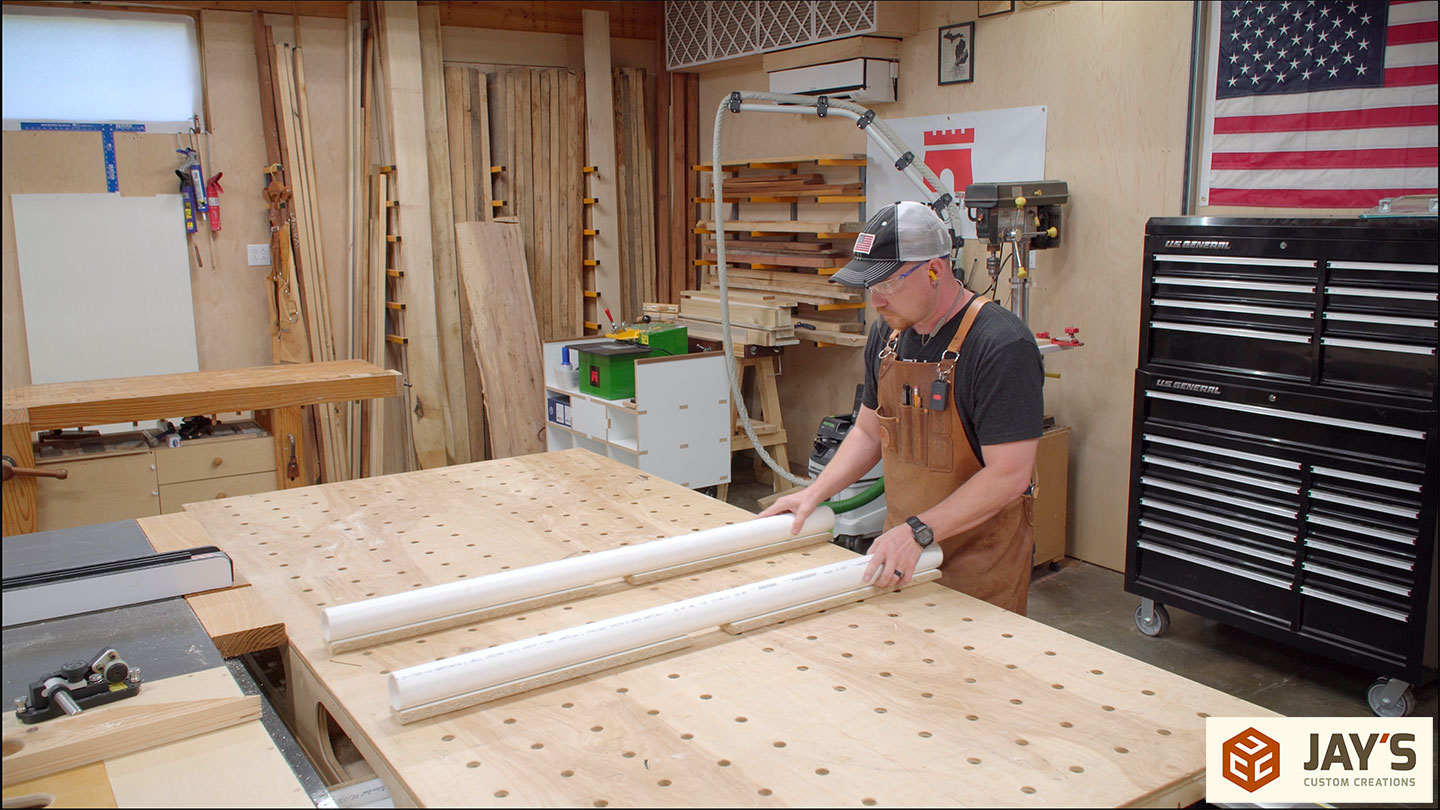
Each and every leg clean might be a lamination of 2 forums. So 8 forums general on this four-leg glue up.
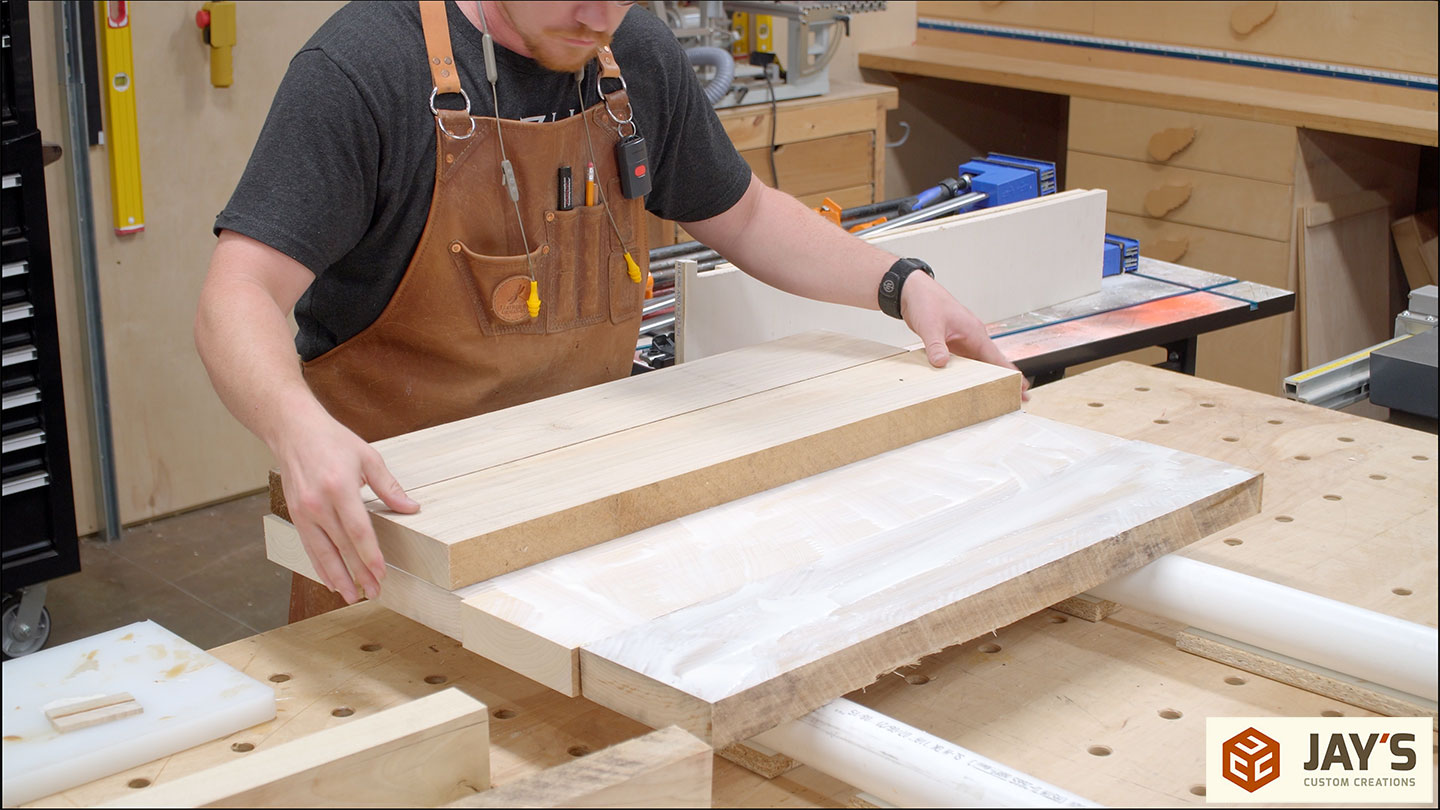
Since the vast faces of the forums are already flat and parallel, I added a work of plywood to every facet of the glue up. Those plywood items gets dented from the clamps fairly than my already surfaced leg portions.
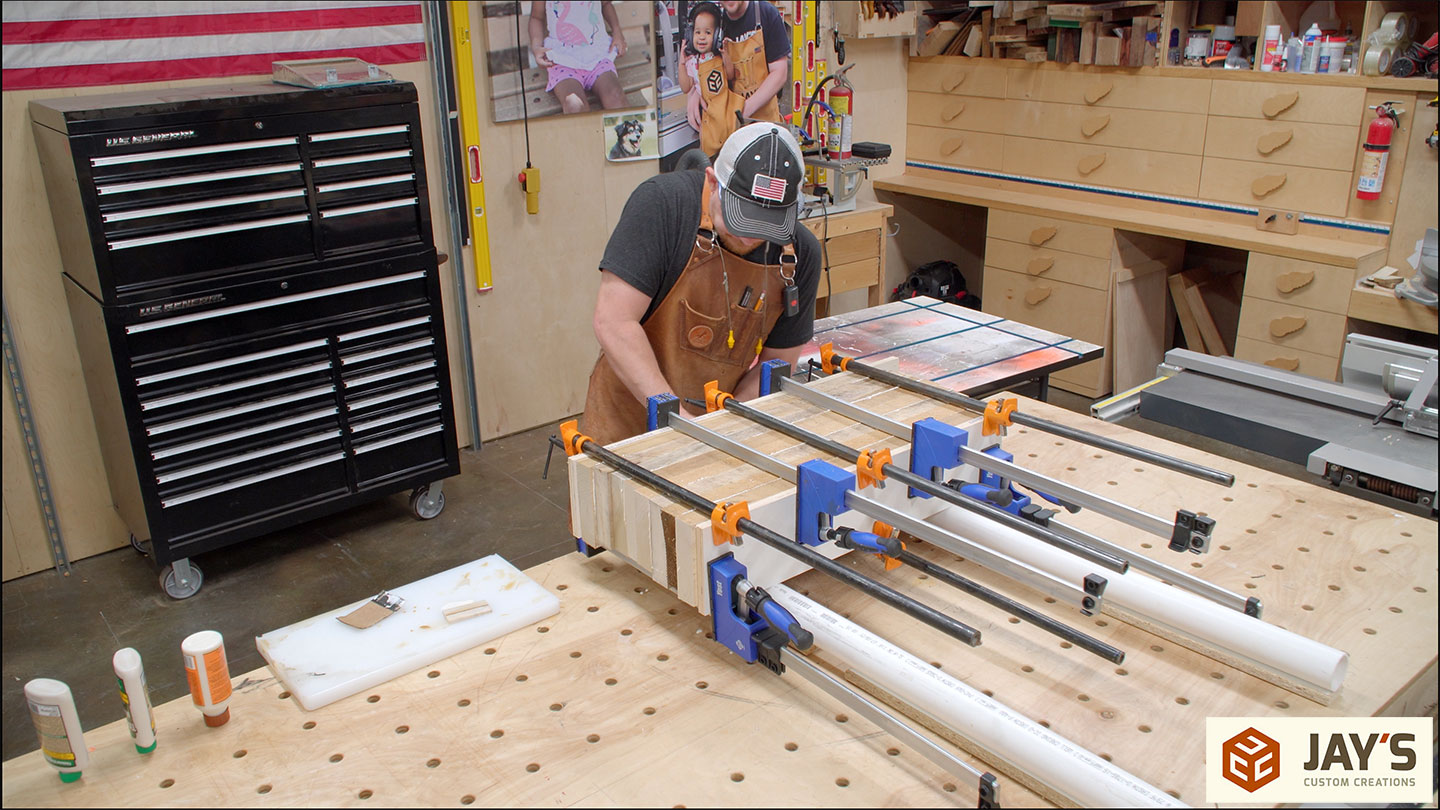
Whilst the leg blanks sit down in clamps, I will get started the milling procedure as soon as once more for the rail items. Step one is sort of at all times crosscutting at my miter noticed station. I’m drawing near the tip of 12 months seven with this miter noticed station and couldn’t consider my store with out it. It’s basically a garage wall that occurs to have a miter noticed in it.

I desire to make use of the bandsaw when conceivable for ripping tough lumber. If the board has any cup or twist, I don’t suggest the use of the desk noticed as the fabric can shift simply when it’s reduce.
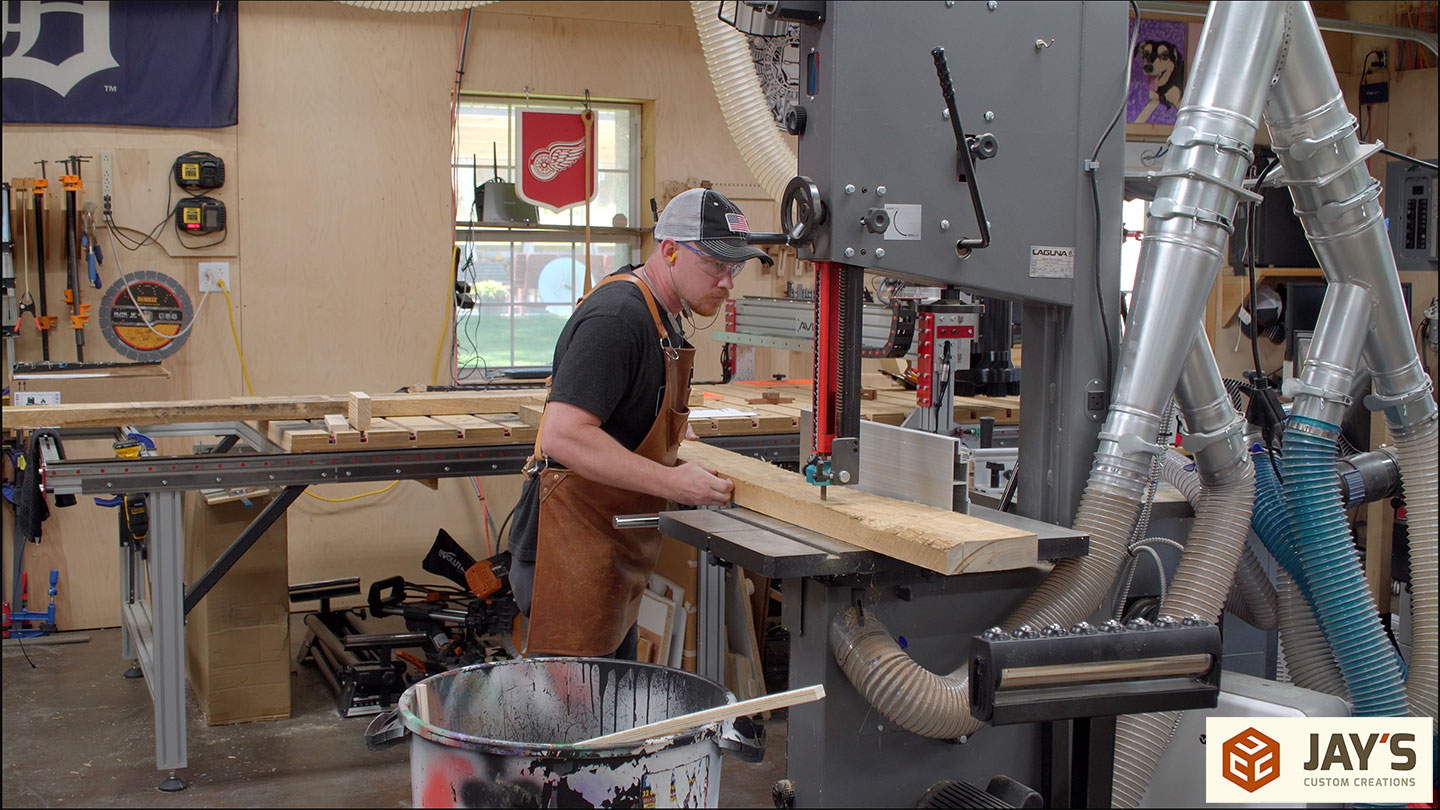
Jointing the lengthy inventory on the jointer isn’t as tough as it’s going to appear. Some other people have requested concerning the “brief” beds in this jointer, and I will’t bitch, to be truthful. Those tables do the activity simply high-quality for longer inventory, and I will at all times use a curler stand if wanted. This board is 85” lengthy.

After the jointer and planer, I will rip to the general duration on the desk noticed. Those JessEm curler guides had been tremendous useful at holding the inventory down and in opposition to the fence. No longer a demand in anyway, however certainly useful.

Once more, curler stands are your buddy with longer inventory. You’ll be able to see one at the back of me right here. It was once arrange to be used on the bandsaw.

The following morning I used to be slightly productive off-camera. I took the leg blanks out of the clamps and were given them sq. on 4 facets to their ultimate width and thickness. My unique design known as for a 3-1/4” sq. leg, however I finished up going with a 3-1/4” x 4” rectangle. I simply couldn’t deliver myself to bring to a halt 3/4” for no reason why rather than holding the legs sq.. Having a look again, I’m happy I made this resolution as a result of I feel the oblong legs supplement the oblong desk.
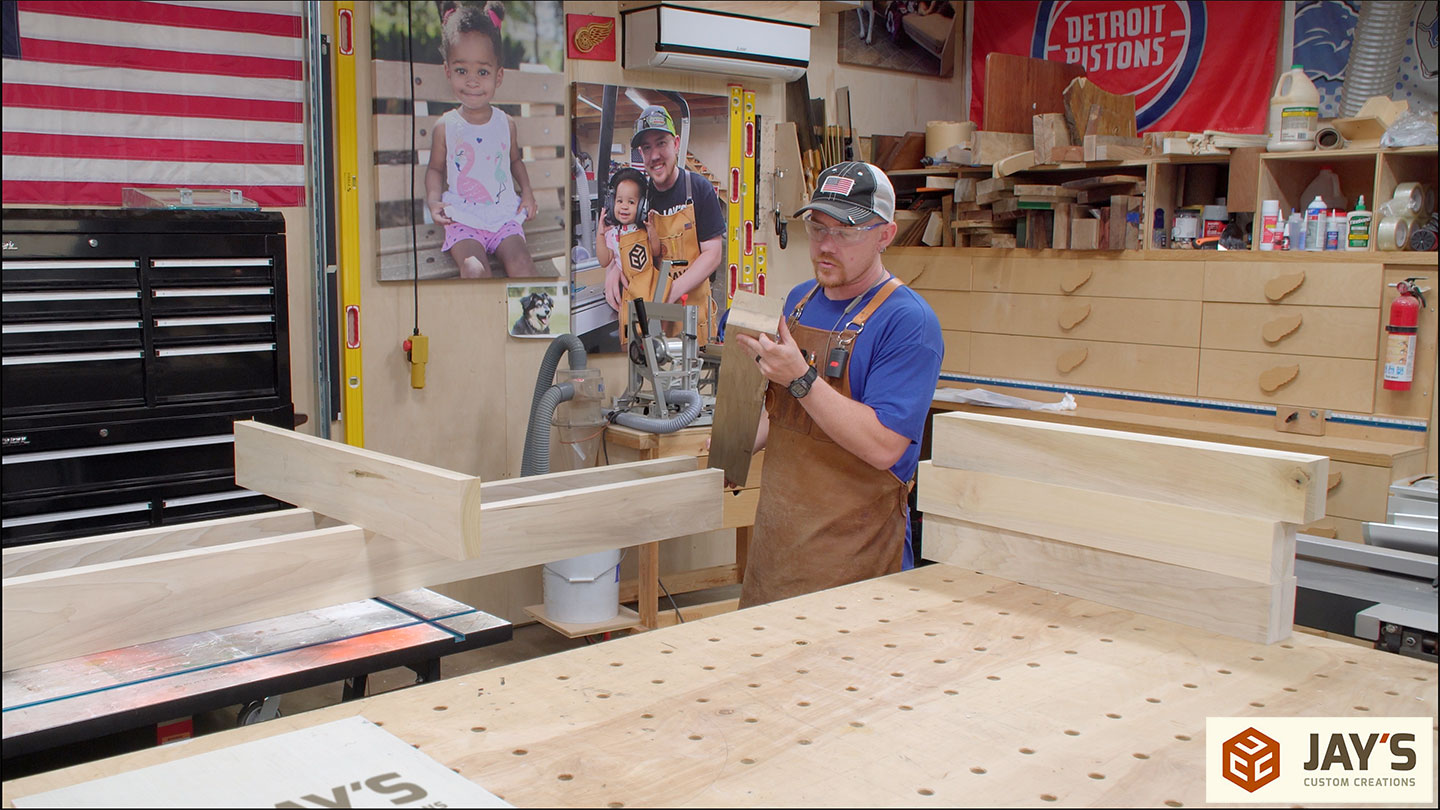
For the joinery, I’m the use of the Pantorouter. It’s a surprisingly flexible joinery device. Principally, it’s a pantograph with a router connected. It strains templates at a 2:1 aid from the template to the picket. So you probably have a ten” template, you’re going to get a 5” joint. Mortise and tenon, sliding dovetails, rabbets, dados, field joints, dowel joints, common dovetails, you title it, and this factor can do it (for essentially the most section).
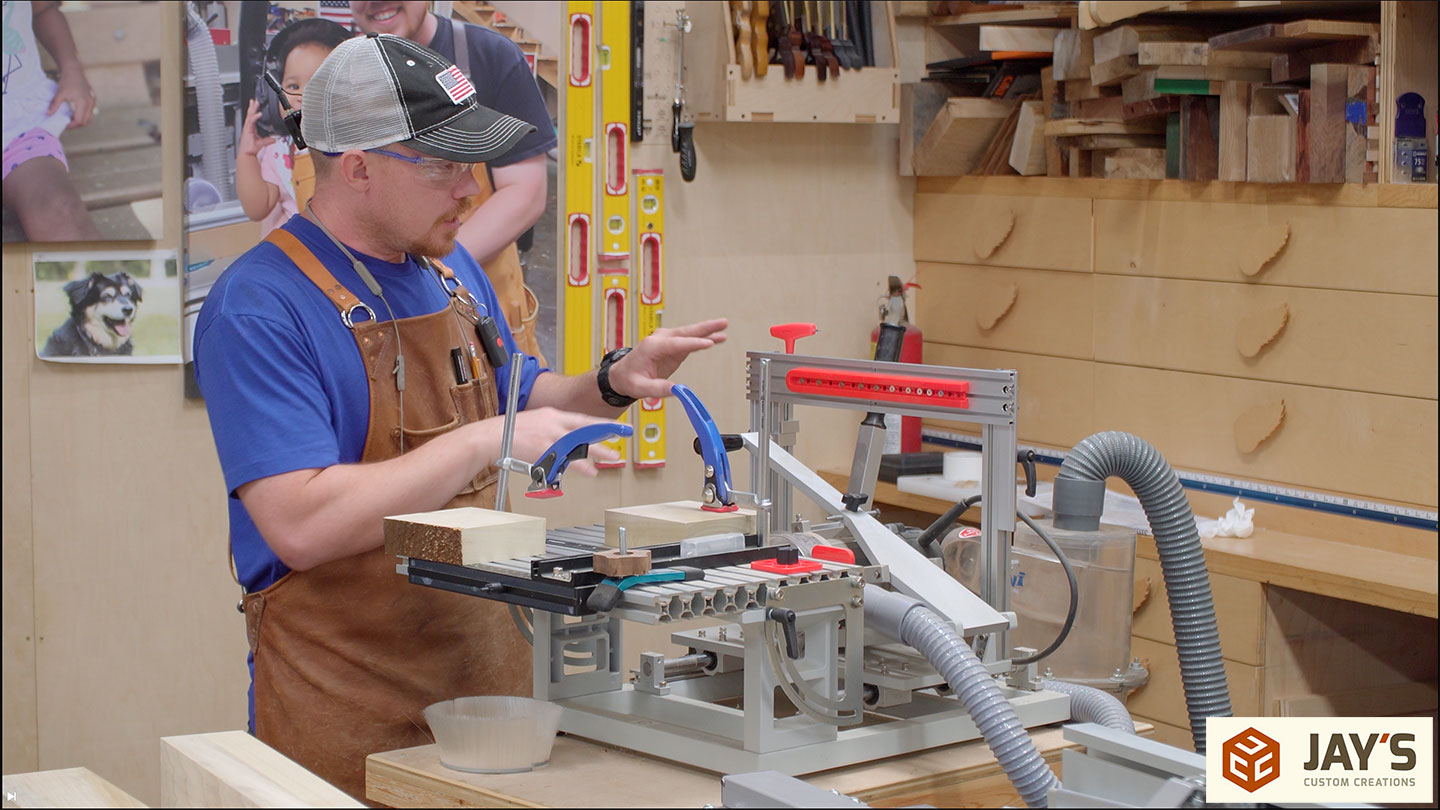
For a sliding dovetail, I’ve a stopped slot template put in. That is in reality a segmented template with 3 portions. The nearest to me is a rounded template finish section adopted by way of two longer immediately template segments. This permits me to seize the bearing follower throughout the template for the feminine facet of the joint and now not possibility by chance losing the router onto the desk floor. The template lets in me to plunge into the highest of the leg and prevent at a specified distance.
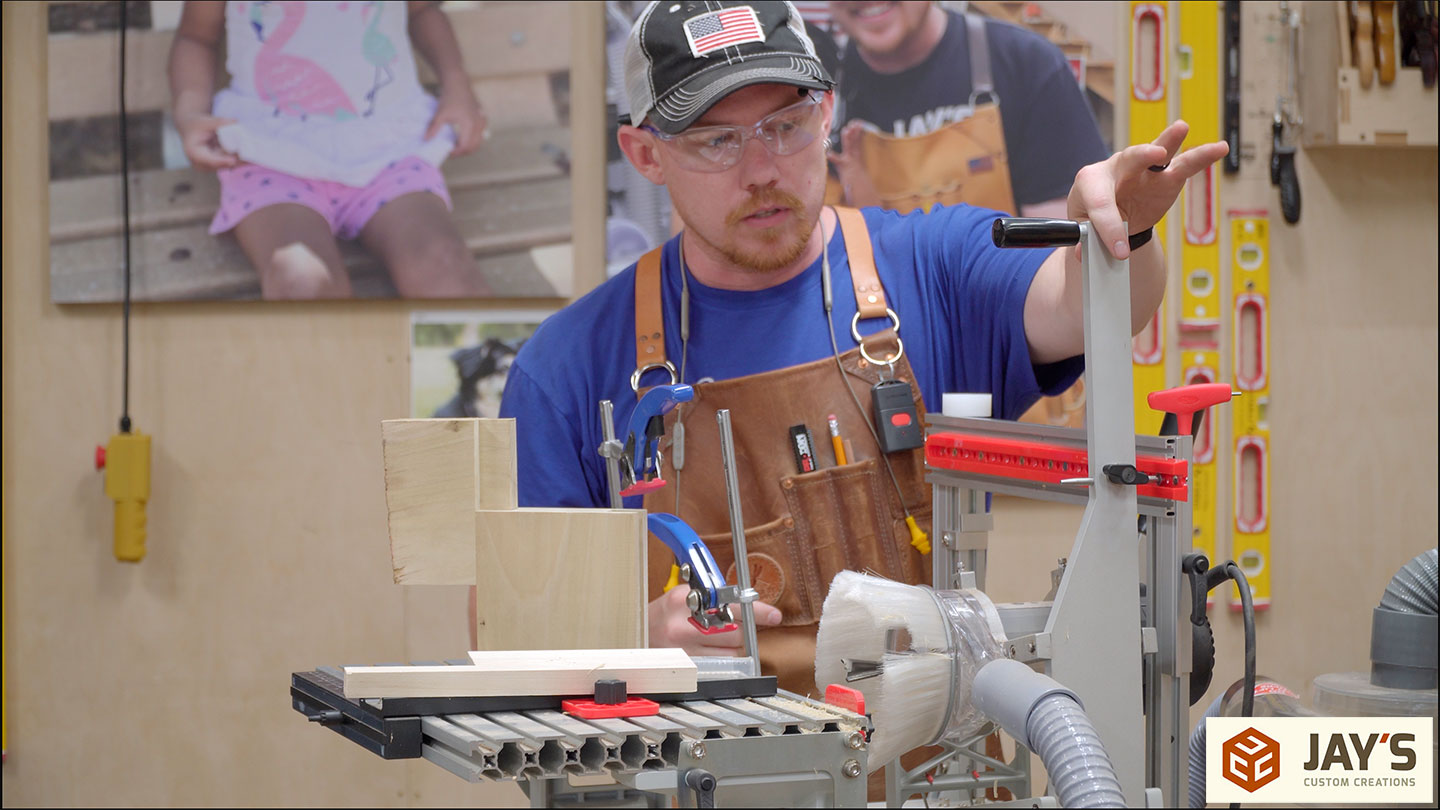
The feminine facet of the joint takes about 24 seconds to chop, in line with my video clips. The dovetail bit I’m the use of has a 13/16” backside width, and I set the device for a 1” deep reduce. That’s a tight quantity of subject matter to take away in a single cross, particularly taking into account I’m plunging into finish grain. The bit and device treated it with out a downside.
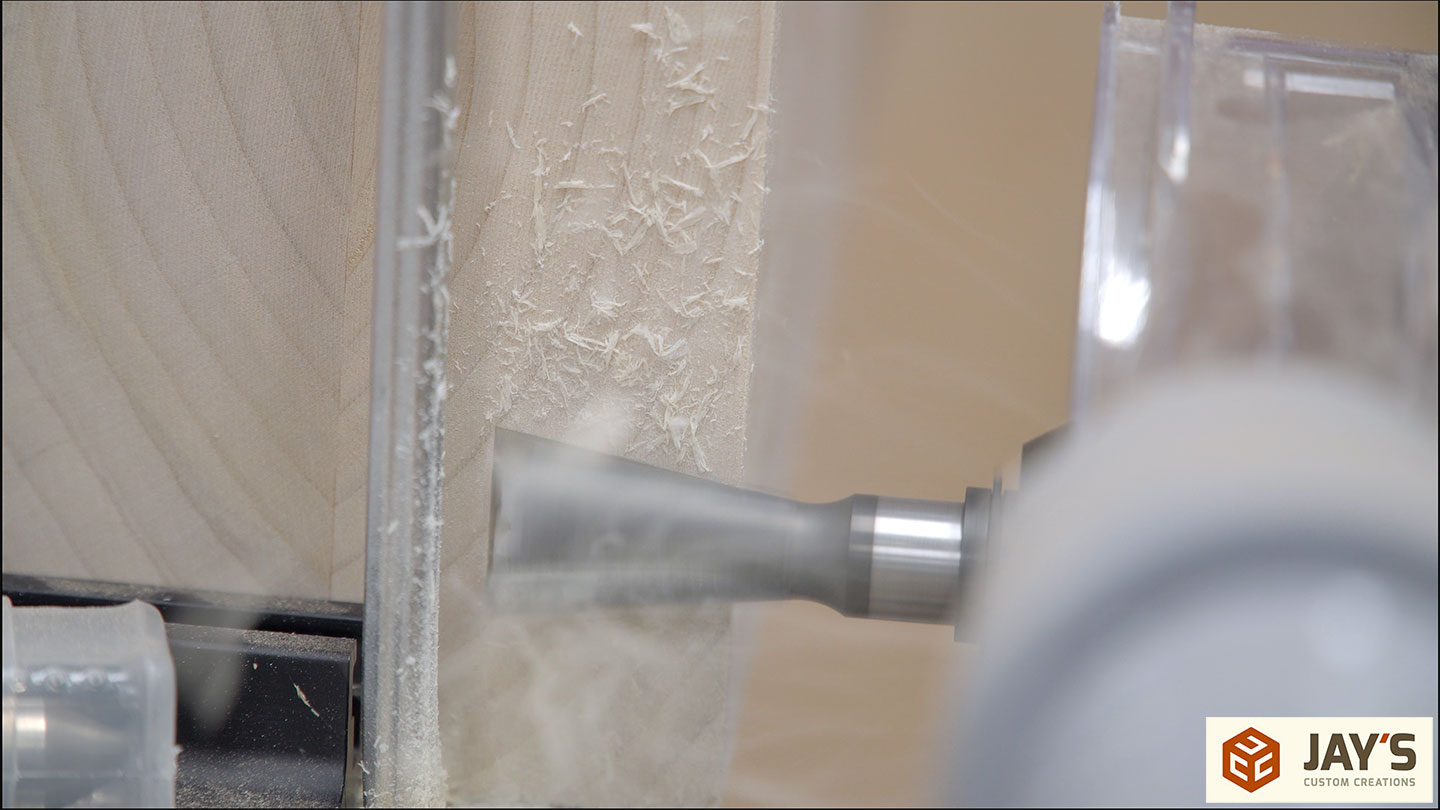
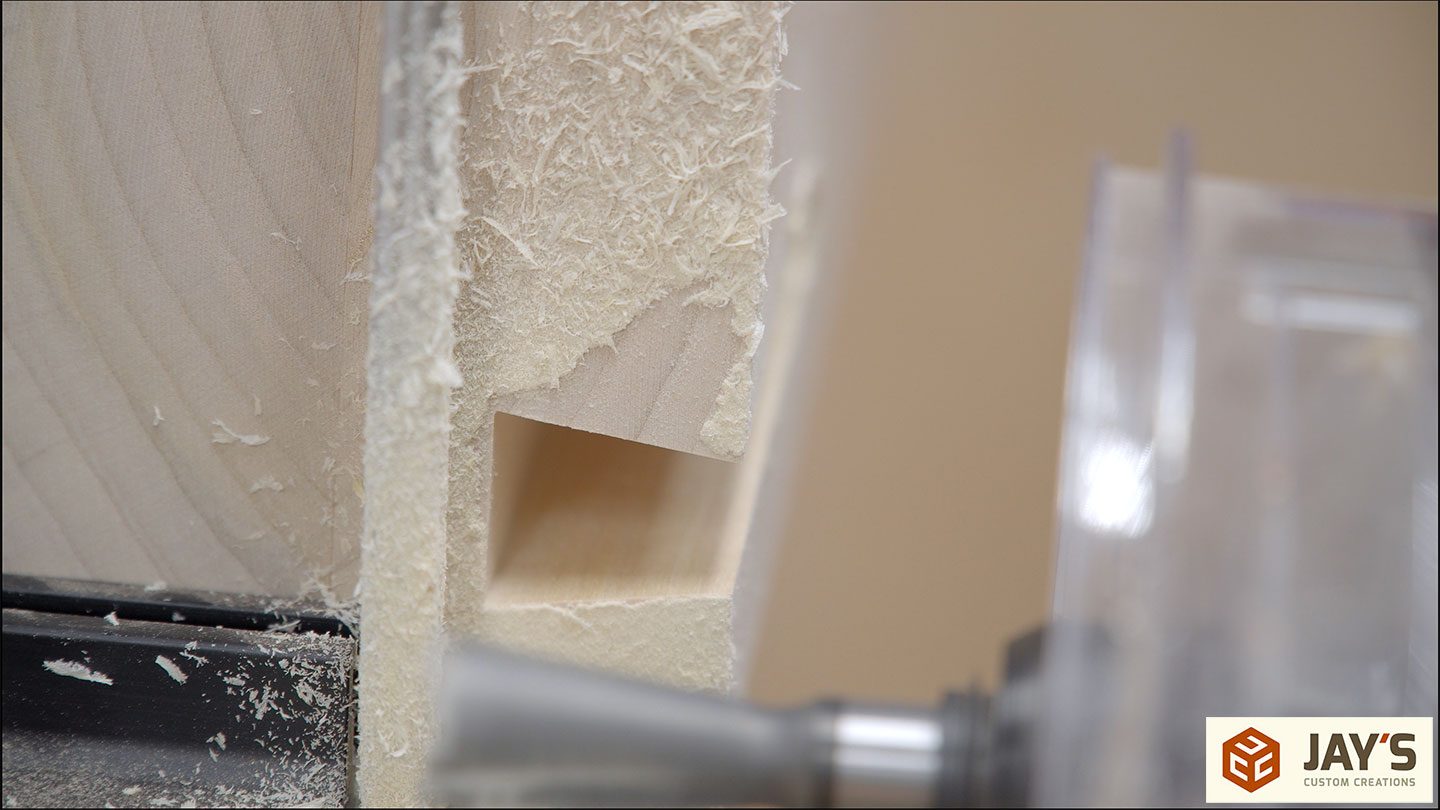
This was once a fun-looking shot, so I incorporated it within the video. The 4 legs with the 8 dovetail slots.
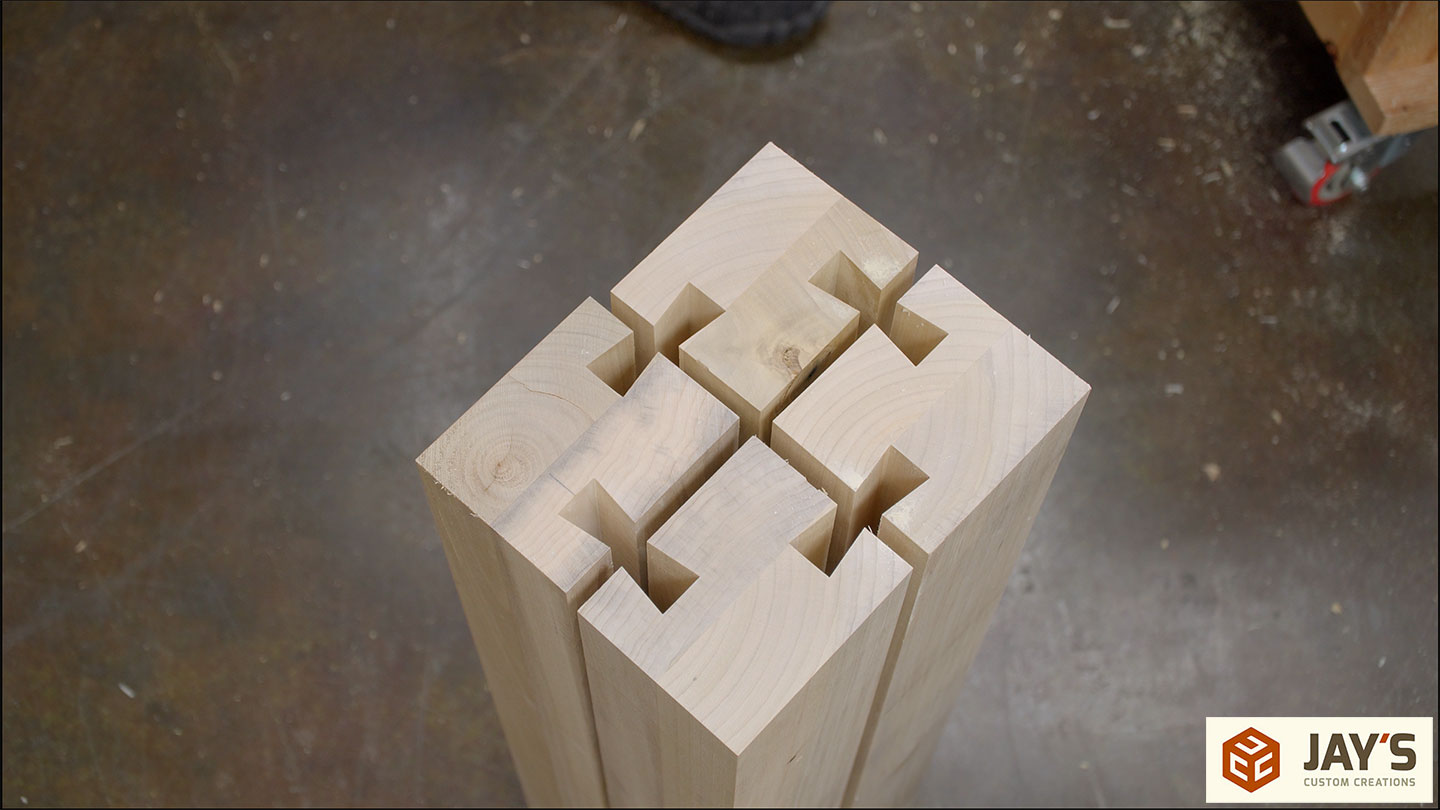
Subsequent up, the male facet of the joint is reduce with the Pantorouter follower at the outdoor of the template.
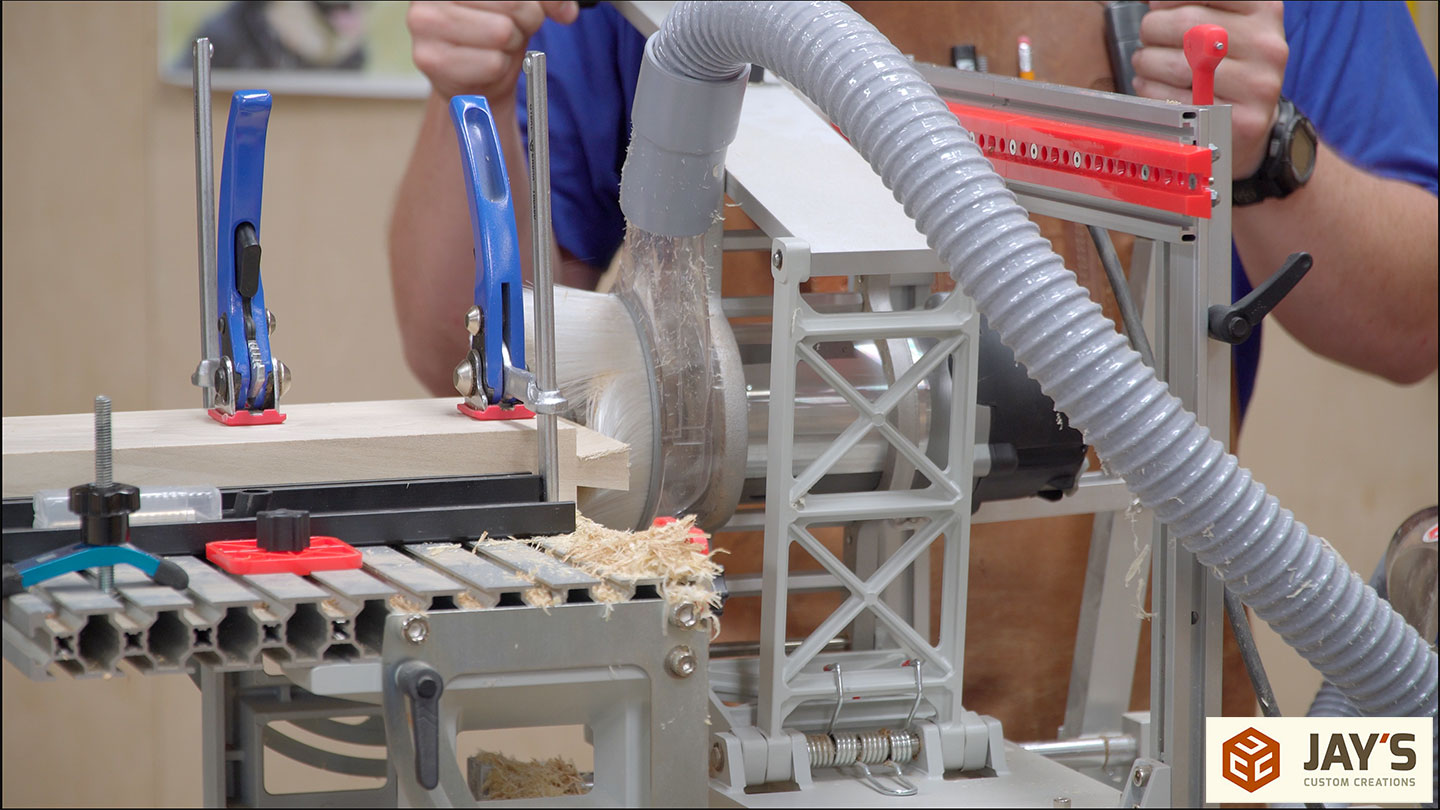
That is the place the Pantorouter shines. I’ve a vertical desk on my CNC device, so I may technically reduce those joints. However NOT at the lengthy rails. The peak of my CNC spindle is the restricting issue for finish grain paintings. On this case, you’ll be able to arrange subject matter fortify at the reverse finish of the board and reduce a nearly limitless duration.
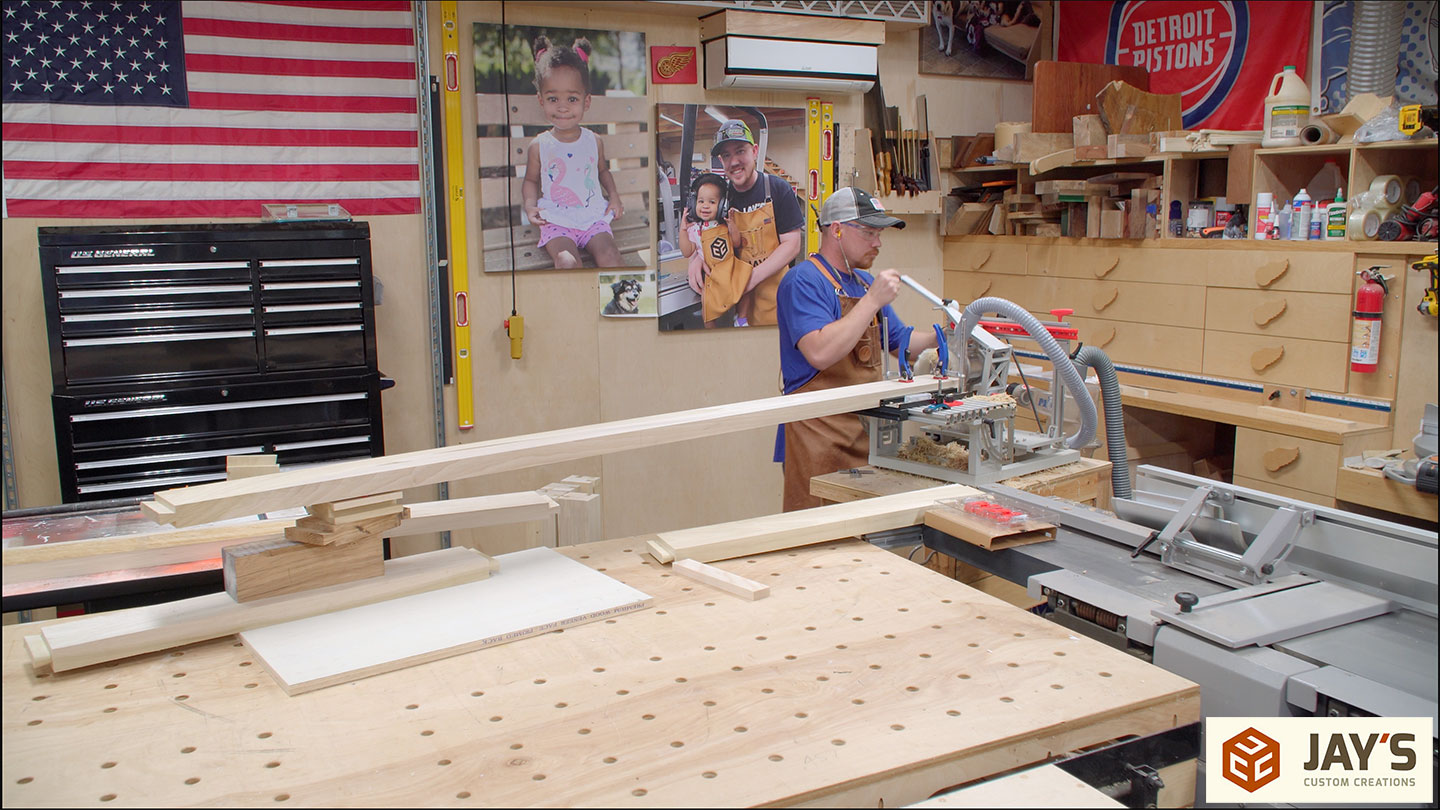
This desk might be a sexy fundamental design. A easy, daring glance is what I’m after, so stopped chamfers on the entire edges are all that I’m including. With a get started and prevent line marked on my router desk, the chamfers may also be reduce simply on the router desk.
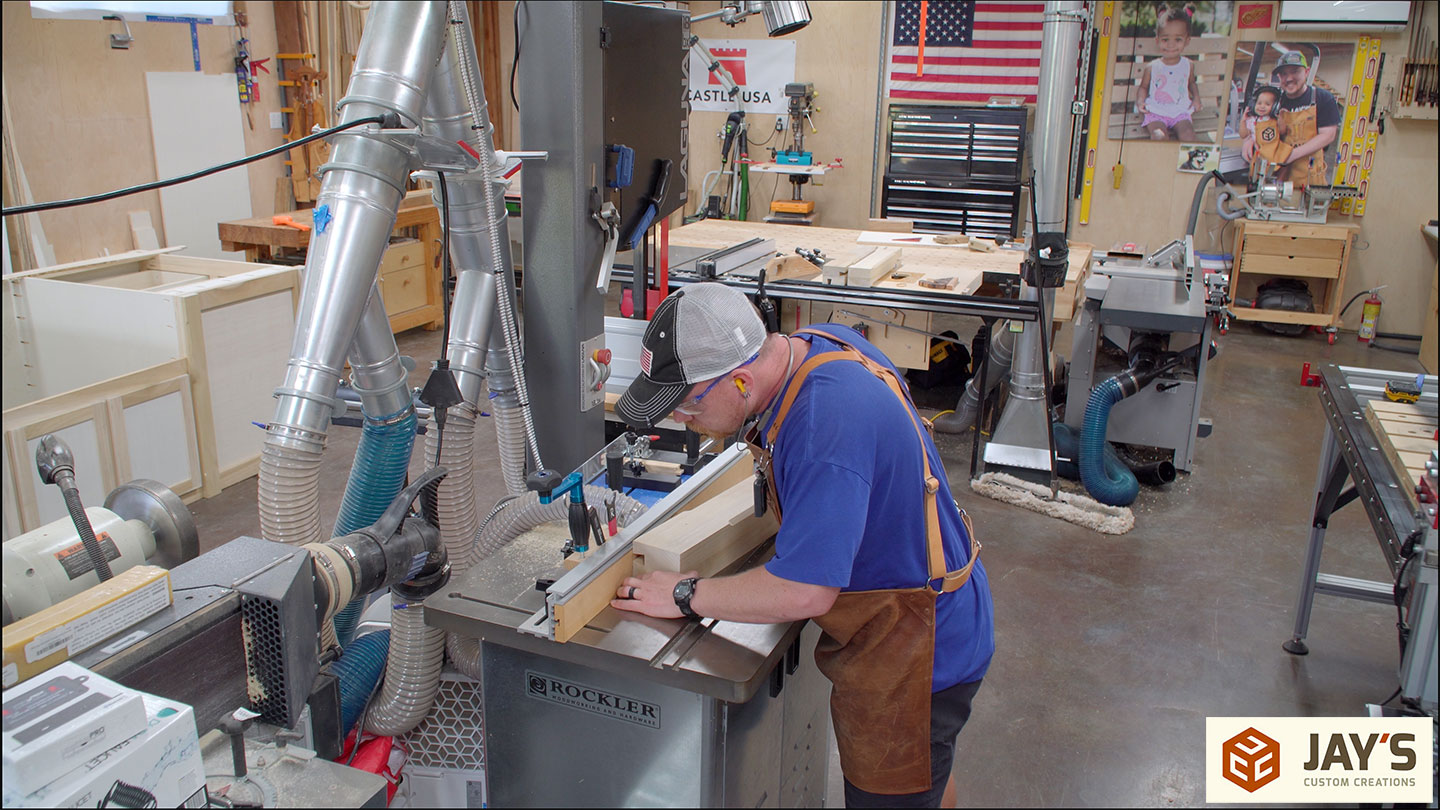
Whilst the legs gained’t technically contact the concrete, I’m including a chamfer to the ground of the legs anyway. ALWAYS chamfer or roundover the ground edges of your chairs and desk legs. Principally, any piece of furnishings that has legs wishes some more or less reduction reduce at the perimeter of the leg to stop splintering when drug around the ground.
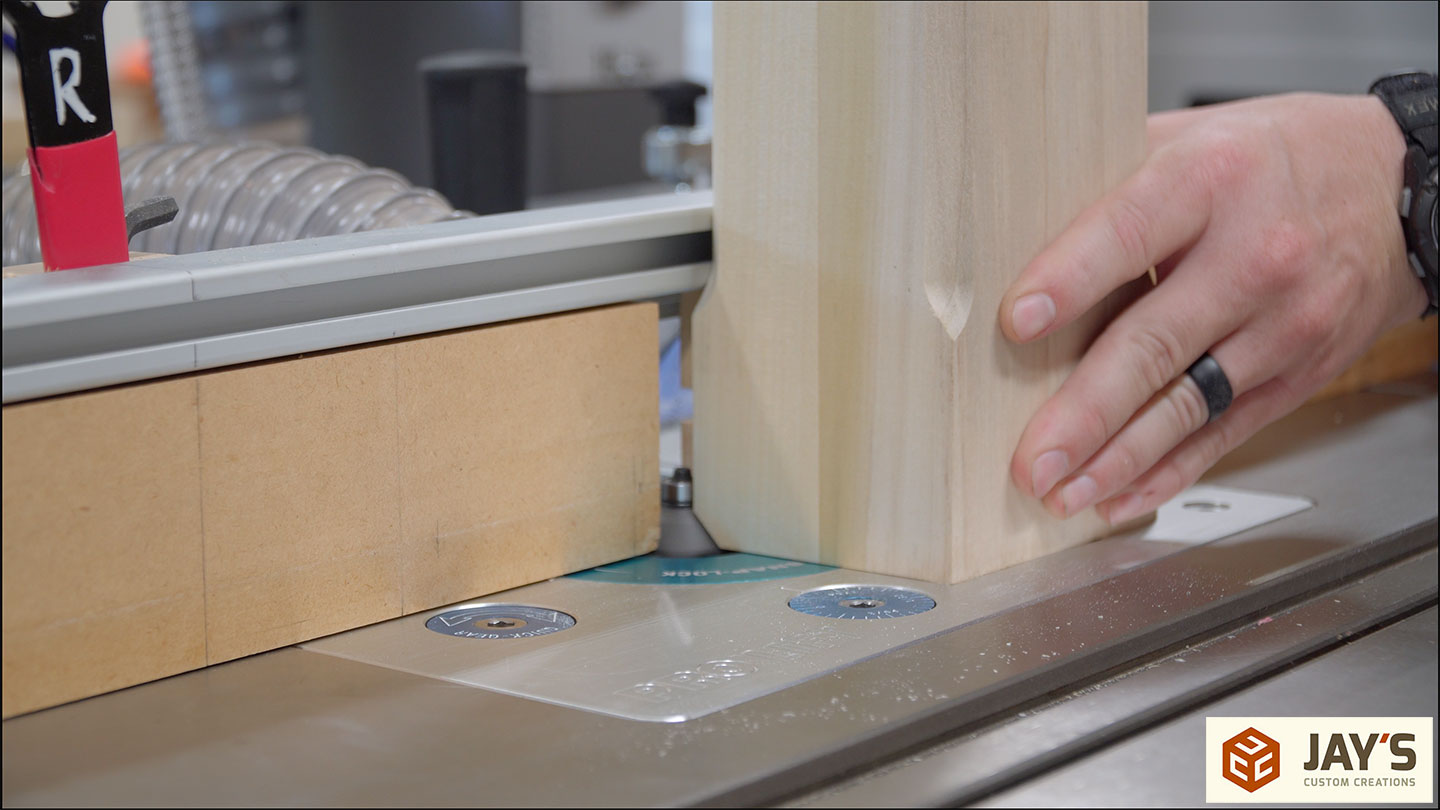
It’s additionally a good suggestion to make use of a backer board to stop tearout.

Right here’s the place I bumped into slightly of a snag. I’ve a pleasant set of picket faucets that I love to make use of every time conceivable. Then again, the faucets working throughout the poplar finish grain led to torn fibers. Poplar is simply too cushy to be tapped at the finish grain. All of my threads had been ripping out with a 1/2” bolt. I deliberate to make use of those 1/2” bolts as leg levelers.
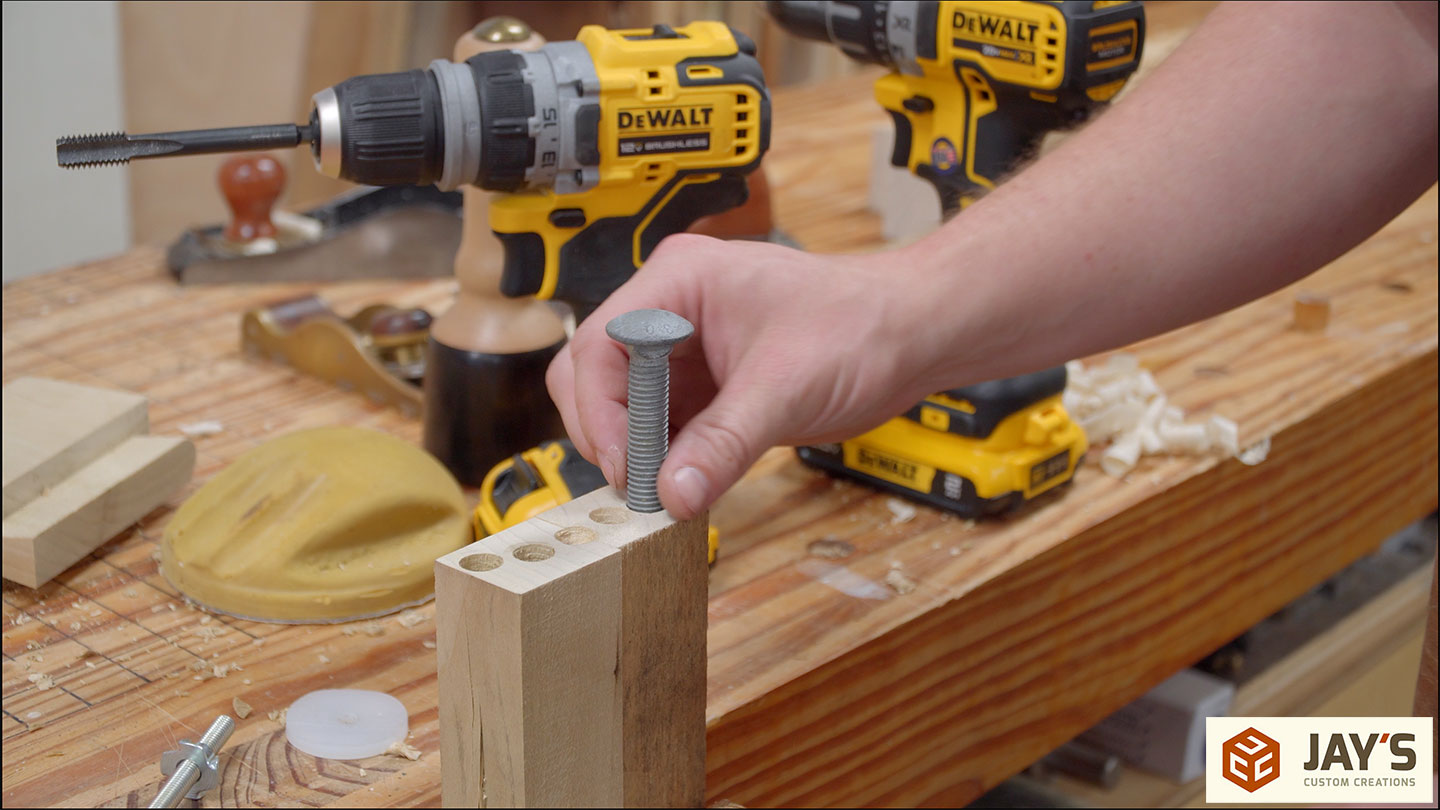
Plan B was once to make use of my outdated trusty. A 5/16-18 T-nutt with a 5/16-18 galvanized carriage bolt is what I in most cases use. On this case, I’ll have to make use of it right here. That is the least dear possibility I do know of for foot leveling.
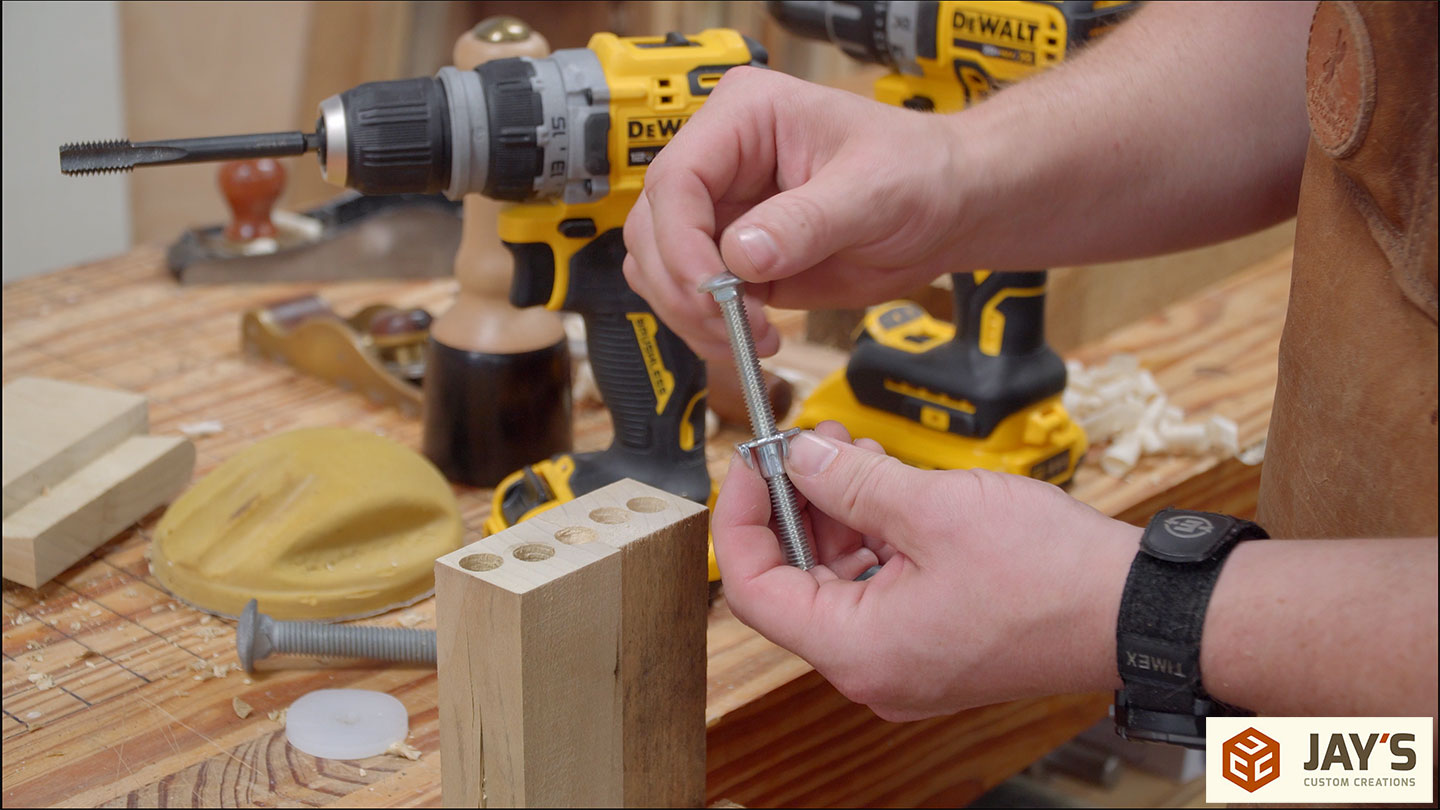
Time for meeting of the desk. I set the Pantorouter to provide cosy joints proper off the device, so PVA glue was once now not an possibility. PVA glue (Tightbond and identical) is water primarily based, so it is going to swell the joint all the way through meeting. On an already tight joint, this isn’t what you need. As a substitute, I went with epoxy. It lubricates because it is going in combination, so there’s no use for over the top pressure to seat the joint.
The primary motivating issue for me to make use of sliding dovetails for the joinery was once the truth that no clamps had been vital. I didn’t have clamps lengthy sufficient to connect the lengthy rails, so I might have needed to attach a couple of in combination to get the whole lot put in. Sliding dovetails had been a lot more uncomplicated. “Glance, Ma. No clamps!”
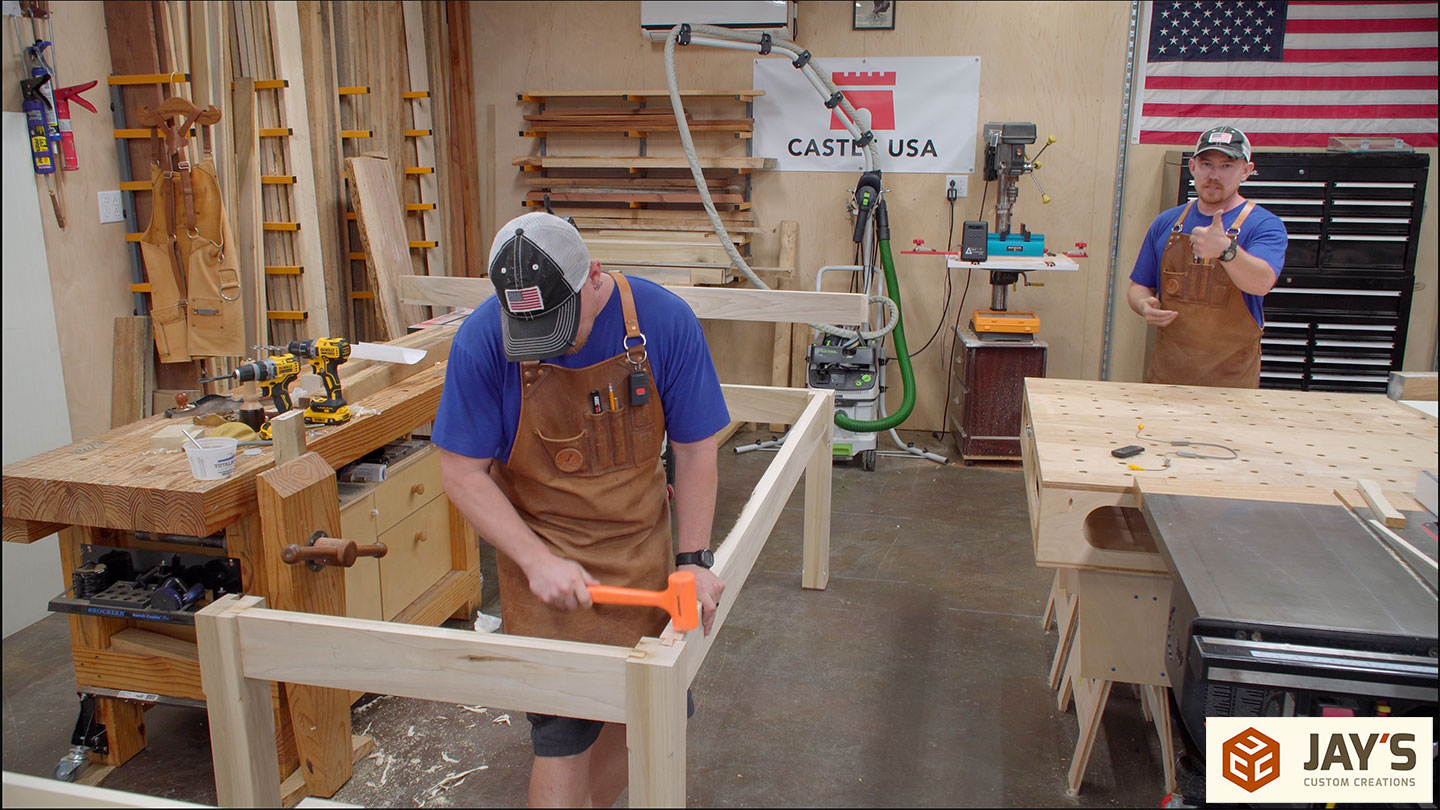
And no fussing with a BFH to get the whole lot seated correctly.
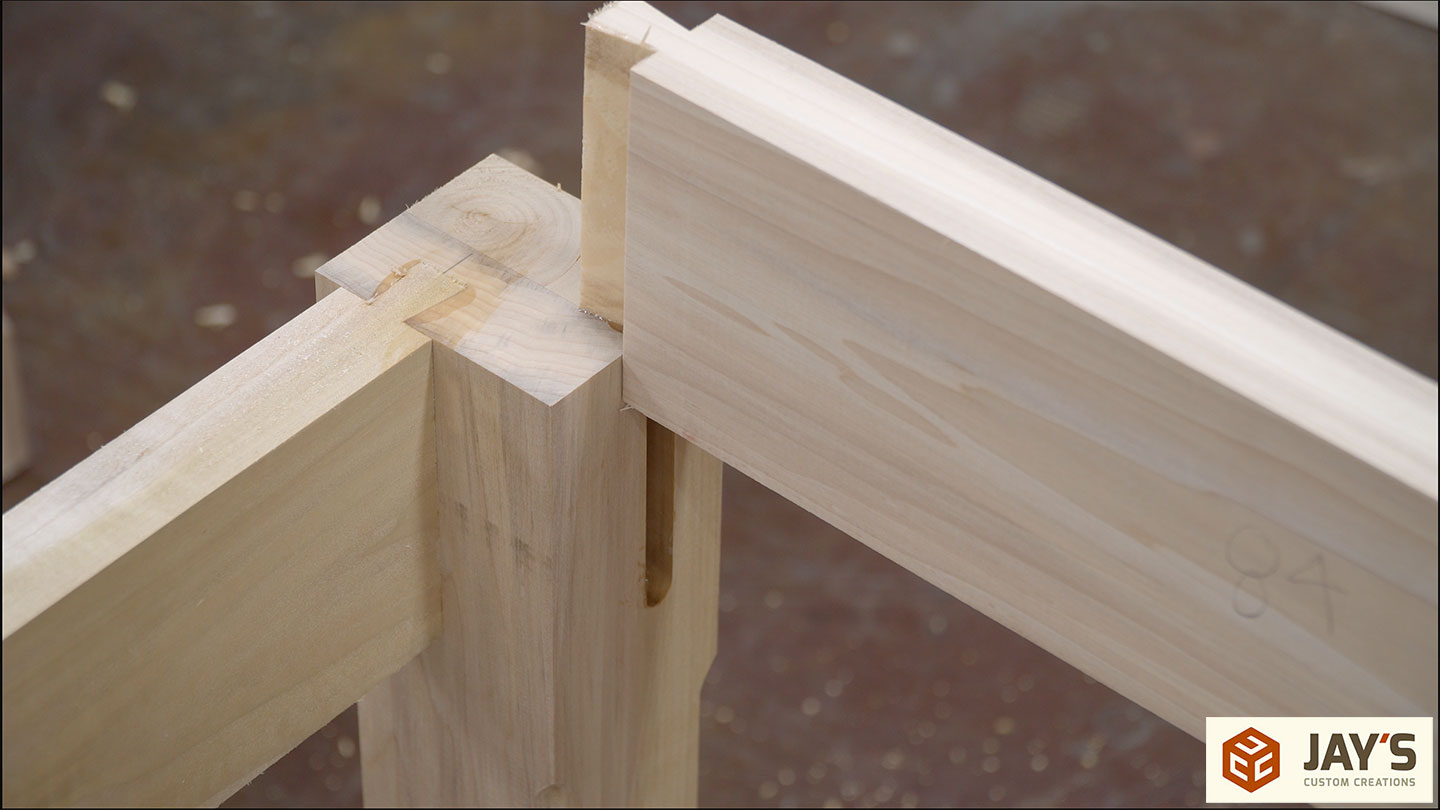
The overall piece of the bottom is a middle fortify rail. This now not simplest is helping fortify the highest however, extra importantly, helps to keep the lengthy rails parallel. With out this board, the lengthy rails may both bow in or out through the years. This rail locks the lengthy rails in position.
Right here’s a tip for you. If in case you have the choice to take action, place the lengthy rails in order that they bow inward all the way through meeting. That approach, the middle rail is sandwiched between the lengthy rails, and the pocket hollow screws that preserve it in position are simply locking the location. If in case you have the lengthy rails situated bowing out, then you’ll have to set up the fortify rail with clamps and screws. When the clamp is got rid of, the screw threads do all of the paintings to stay the lengthy rails parallel.

A biscuit joiner is an ideal software for tabletop hold-down clips. I used those clips for each desk that must be connected to a base the place enlargement and contraction are vital. See the video for a greater visible rationalization.

And that’s it for the desk base. I sought after to shift gears from the sink island to this desk base as a result of they’ll be completed with the similar Tuscan Purple milk paint from Common Finishes.
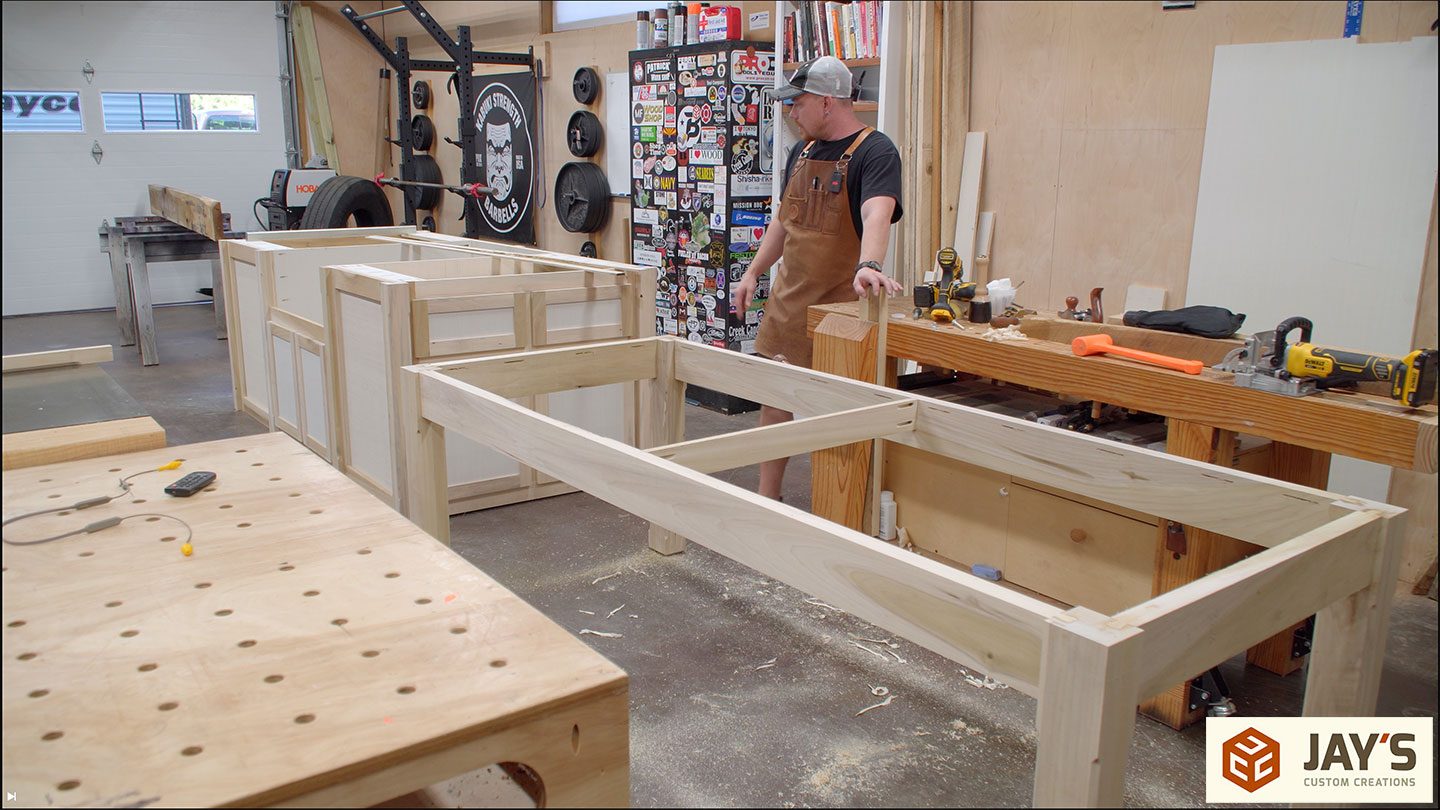
I’ll go away you with the SketchUp photographs of those two items of furnishings. As you’ll be able to see, the bases are the similar, and the highest panels are the similar. The island gets door and drawer pulls that fit the highest, and the desk gets an extra trim piece under the rails that fits the highest. Keep tuned, as those items are already just about whole. The colour grew to become out GREAT!
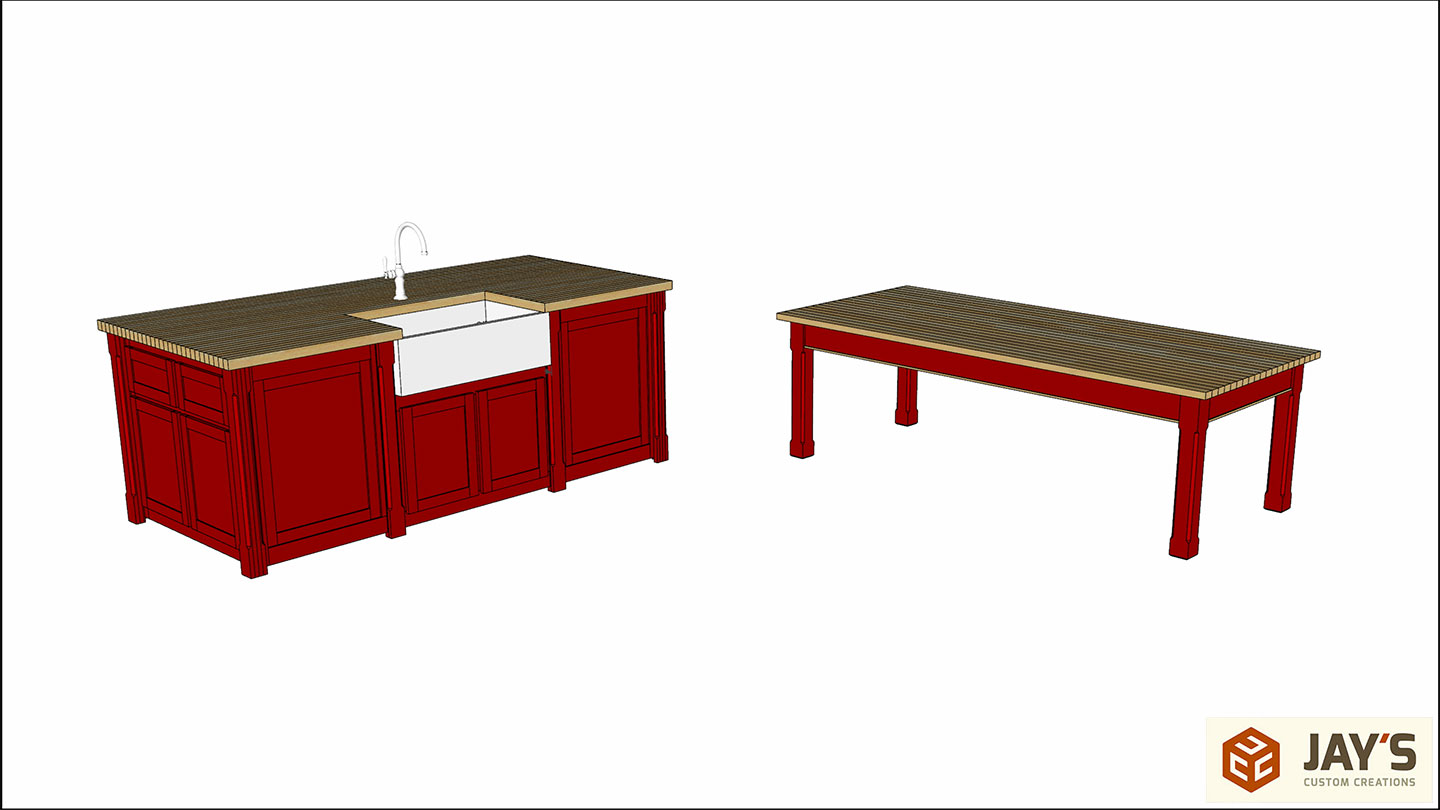
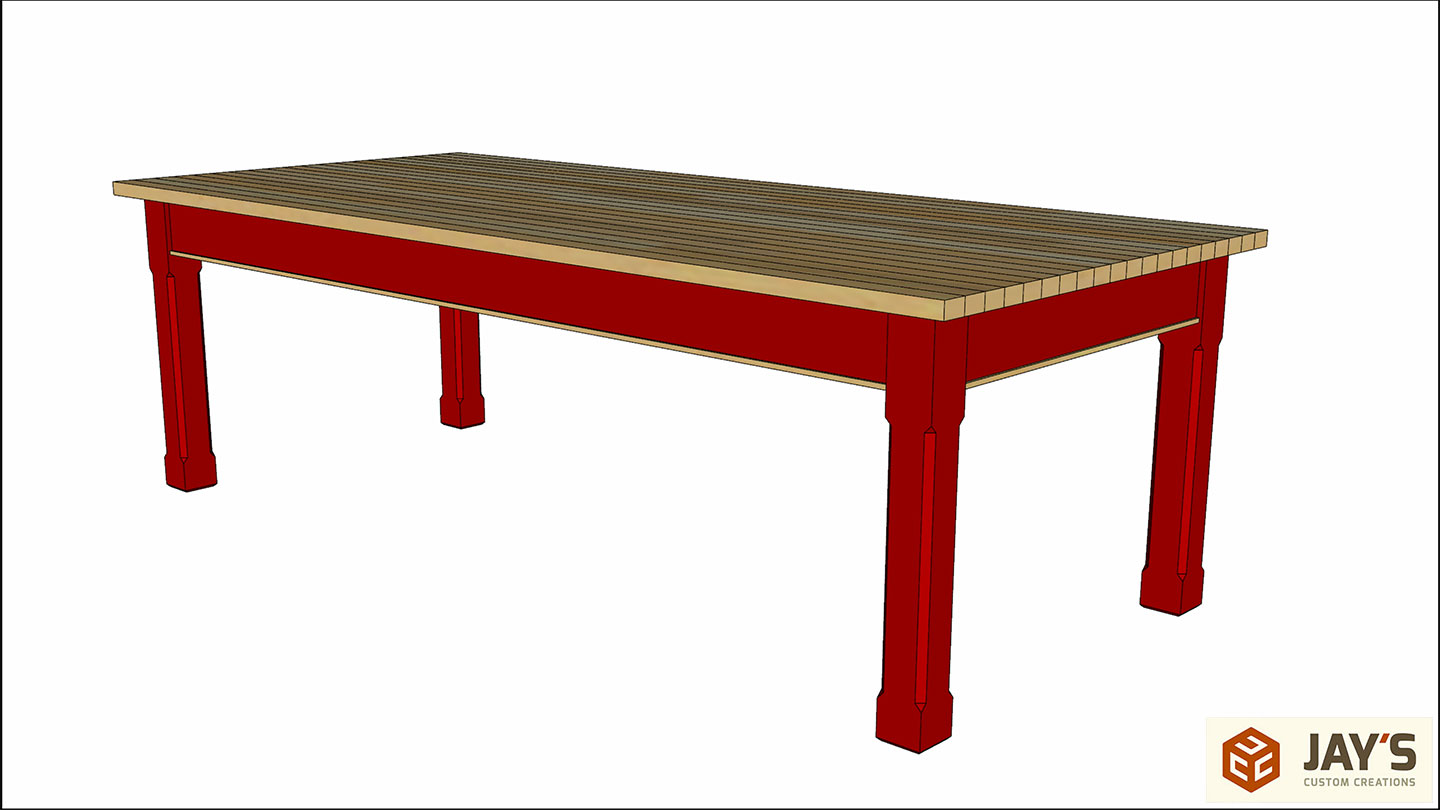

I exploit coloured waxes relatively so much in my completing, particularly the darker colours. I’m partial to Liberon’s Black Bison Paste Wax, however that’s as a result of it’s the best logo I’ve ever used.
Coloured waxes are a secret weapon when it comes to muting a in particular loud or brash colour. Additionally they upload a intensity to many finishes via including a 2nd hue to the full piece.
Many vintage restorers use black wax to upload age to a end or a restore, and it’s nice for that. However that’s now not my purpose with black wax. I am hoping the footage right here will provide an explanation for it higher than phrases.
First, forget about the gross sales reproduction concerning the stuff.
“(I)t feeds, polishes and is helping to save you picket drying out…” No, it doesn’t.
“Giving a extremely lustrous and hardwearing end…” It in truth offers a low-luster end. And, like any waxes, isn’t in particular sturdy.
“Well known for its high quality and delightful, unique aroma…” Uhhh, these things smells like a Fifties cleansing resolution for septic tanks. It isn’t delightful. However the odor dissipates.


Right here’s what it in point of fact does. It’s a fast-drying sludge. Select a colour. I exploit “Darkish Oak” and “Tudor Oak” and can not inform the adaptation. While you apply it to uncooked picket, reminiscent of oak, it is going to darken the oak and accumulate within the picket’s open pores. When used on uncooked closed-pore woods, reminiscent of pine, it most often looks as if a smeary mess (a take a look at board will verify this).
I generally apply it to best of a end, both shellac or paint. When used over shellac, it is going to cut back the brashness of the brand new shellac, and the wax will accumulate within the pores of the picket, giving the piece just a little of measurement.
I like the combo of mahogany, shellac and black wax. That’s what I exploit on nearly all of my marketing campaign items.
When used over paint, the black wax will get just a little smeary. It’ll accumulate in small voids left within the paint. And it is going to buff off inconsistently at the paint. This can be a excellent factor. A vibrant new paint end can seem like you dipped your furnishings in Plasti-Dip. The asymmetric absorption of the wax mutes the one colour.
Software
The stuff dries briefly, so I like to recommend you’re employed small spaces, about 12″ x 12″. Wipe the wax on generously with a rag so you’ll be able to push it into the pores and small voids (put on protecting gloves). Stay wiping the wax till you may have a skinny, constant coat. Then right away start wiping it off with a blank, coarse rag (I exploit towels with a Huck weave – mainly surgical towels). Stay wiping till you can not take away to any extent further. Then transfer on to the following segment of the challenge.
When you botch a bit, merely observe extra wax. The wax’s solvent will dissolve the onerous layer and you’ll be able to wipe once more. Or dab some mineral spirits on a rag and you’ll be able to rub the skin to take away skinny layers of wax till you get the impact you wish to have.
If at any time you hate the end, flood the skin with mineral spirits and rub onerous. Many of the wax will come off.

Check Forums
Making take a look at forums is the one manner to be certain you are going to get the impact you wish to have. I’ve used the wax for many years and nonetheless do a take a look at board earlier than I get started smearing the stuff on anything else.
A tin of these items lasts for a few years, so don’t be eliminate via the top value (about $35-$40 right here within the U.S.). Don’t be eliminate via the odor (we name it the “pungent janitor” wax as it smells like some cleansing fluid from my youth). And don’t be eliminate via the bison phase. I believe there’s hardly ever any bison within the wax.
– Christopher Schwarz
Synopsis: Becoming hinges is without doubt one of the largest demanding situations for new boxmakers. This jig is helping Doug Stowe’s scholars get completely matching hinge mortises on each the field and its lid. This jig merely clamps to the field frame and the bench, and slides to the opposite finish for the second one mortise. Recommendations on the use of the jig and adapting it to other tasks are integrated.
I’ve made a large number of boxes and taught a large number of other folks the way to lead them to. One of the most spaces that scholars to find maximum difficult is becoming hinges to a just about completed field. To lend a hand my scholars throughout all categories and boxes, I devised a quick-and-easy jig with notches for the router to practice and a fence to place it in opposition to the workpiece. The jig all however promises completely matching mortises within the field and its lid. Fortunately, it really works simply as smartly for me in my very own store.
Finish stops are the important thing to clean registration With notches sized to a particular hinge and a fence and forestalls for certain reference, this no-frills jig takes the headache out of becoming hinges to a field and its lid—or many boxes and plenty of lids. The top stops lend a hand make sure that correct alignment between the field and lid. |
Tailor your jig on your router, hinges, and boxes. The jig’s base will have to be 1 in. or extra longer than the longest field you are expecting to make with a specific hinge and vast sufficient to with ease strengthen your router. I discover a trim router to be superb right here, because it’s small, light-weight, and clean to regulate. I take advantage of a three ⁄ 16-in.-long dado blank out bit from MLCS (merchandise no. 5382).
Since the notches within the jig are sized to a particular hinge, you wish to have to make a separate jig for each and every measurement of hinge you’ll use. Fortunately, making one is a work of cake.
To put the notches, make a decision how a ways you wish to have each and every hinge from the tip of the field. Typically 1 in. or so works smartly for the vast majority of small and medium boxes I make. That distance assists in keeping the hinge screws safely clear of the corners so that they don’t compromise the joints.
On the tablesaw, I reduce the notches to the precise width of the hinge. Arrange two stops on a sled to restrict the side-to-side go back and forth of the jig base. After each and every reduce, attempt to are compatible the hinge within the notch. Preferably, the primary reduce can be too tight, letting you faucet a prevent away as you creep up on a cosy are compatible.
Surroundings the blade top calls for some math, now not take a look at becoming. It must be raised sufficient to account for the hinge mortise plus the width of the fence. I want about part of the hinge barrel to stay out in the back of the field, offering a complete vary of movement. So that you could decide the intensity of the sawcut, measure from the brink of the hinge leaf to the barrel and upload 1⁄2 in. for the width of the fence.
After homing in at the notch at one finish, turn the bottom finish for finish and reduce the second. As a result of I turn the bottom to chop the second one notch, each notches can be similarly spaced from the tip of the jig, simplifying the jig’s use.
To complete the jig, glue at the fence and finish stops, being cautious that the strips are flush with the fringe of the bottom.




To rout the mortises, I take advantage of the dado blank out trend bit discussed previous. Its brief reducing duration method there’s a lot of room left for the bearing to sign up at the jig’s notches.
To make use of the jig, clamp it and the field frame to the bench, ensuring the field is tight to the jig’s finish prevent and fence, and rout. If you wish to have to sq. the corners of the mortise, depart the jig clamped in position, since it’s going to lend a hand information your chisel paintings. To rout the opposite mortise, merely slide the jig to the opposite finish of the field and undergo the similar technique of routing and slicing.
For the lid, turn the jig and repeat. You’ll finally end up with matching mortises with little format or fuss.



Surroundings the bit’s intensity generally is a problem, so I like to recommend a take a look at run.
I decrease the bit in order that it extends 1 ⁄ 2 in. (the bottom’s thickness) plus part the thickness of the hinge barrel. I then decrease it any other hair to stay the hinges from binding.
Seize a work of scrap and rout two take a look at mortises. By way of then crosscutting the scrap in two, you’ll put the mortises in combination to simulate the routed field and lid.
Put the hinge barrel on this area. If the hinge falls out, the reduce is simply too deep. As an alternative, you wish to have the take a look at blocks to pinch the barrel in position with an opening of about 1 ⁄ 64 in. between the blocks. Then your hinges will function easily and the relationship between the field and lid will glance blank.


—Doug Stowe is an writer and boxmaker in Eureka Springs, Ark.
Pictures: Barry NM Dima.
Drawings: Dan Thornton.

To view all the article, please click on the View PDF button under.
From Fantastic Woodworking #301
Enroll for eletters lately and get the most recent tactics and how-to from Fantastic Woodworking, plus particular provides.
Obtain FREE PDF
whilst you input your e-mail deal with under.
View PDF